Category: article
You are viewing all posts from this category, beginning with the most recent.
Sharing the wealth...
This topic has always been tough for us, as parents. But I love our financial adivisors, and I think this recent post really nails it. Key quote:
Talk to your kids about what you are doing or not doing for them, explain what your motives are, and re-evaluate your choices based on how things play out. You are not entitled to a certain response, so don’t hold out for it. Be grateful for what you can do.
Read the full article here: www.startribune.com/levin-how…
All the Things I am Thankful for
I thought it would be fun to share a text and picture blog post of all of the things I am thankful for! So here goes, the list is pretty long.
My Grandkids!
Although I am still relatively new to the grandpa game, I love Hannes and Maren a ton! If this isn’t the coolest picture of a brand new big brother I really don’t know what is.
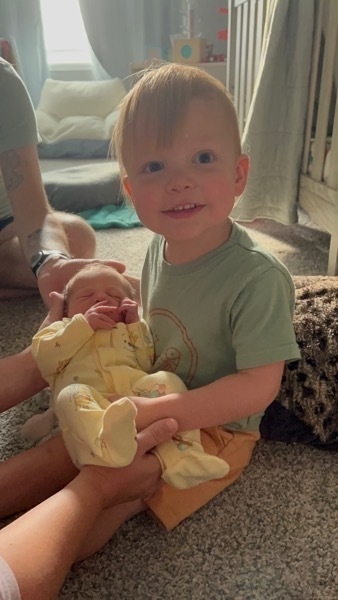
My family!
This was taken before number 2 grandkid was conceived, at our lake house in wisconsin. I think the comma after conceived is important…
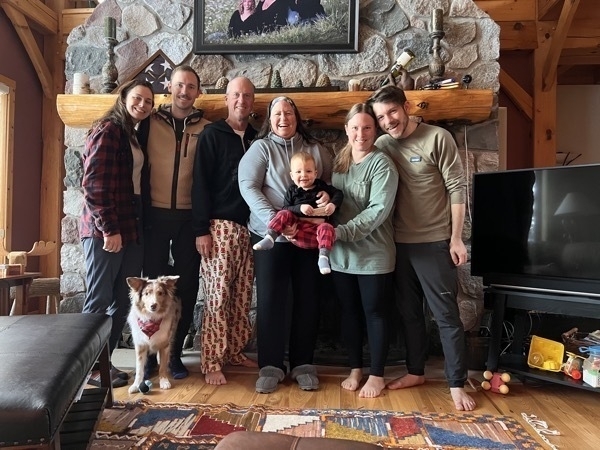
My Wife
My adventure partner, my companion, my everything! I don’t know who else would put up with me after all of these years. COVID times may have curtailed our ability to see the rest of the world, but it definitely increased our desire to see the amazing country we live in. Get yourself a camper and see the USA! This particular picture was taken at Zion National Park. I could post hundreds of other selfies of us from the USA to Morocco to Istanbul to Vietnam, to every other continent (except Antarctica)!
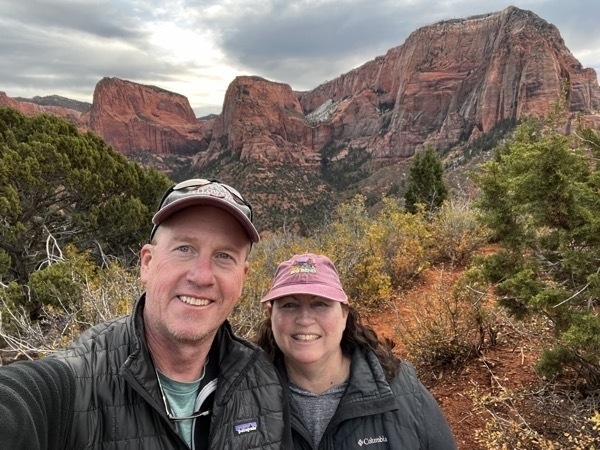
I am thankful that wherever we are we are happy to be there. We have the amazing fortune to have three homes. I know, it’s kind of embarassing, and soon enough we will not want to maintain three residences.
Indio, California
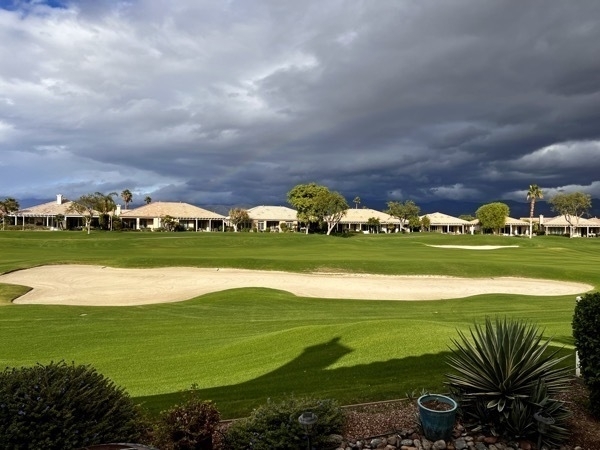 We have made so many good friends here in Indio! From the golf course to the pickleball court to the stage! We are so happy here, and look forward to many more years of "retirement" here at HP. Even though we were not with our kids this year we were lucky enough to invite another couple from pickleball to join us for dinner. We often joke that Heritage Palms is "summer camp" for adults over 55, but it is pretty true, there are so many activities and small groups to get to know.
We have made so many good friends here in Indio! From the golf course to the pickleball court to the stage! We are so happy here, and look forward to many more years of "retirement" here at HP. Even though we were not with our kids this year we were lucky enough to invite another couple from pickleball to join us for dinner. We often joke that Heritage Palms is "summer camp" for adults over 55, but it is pretty true, there are so many activities and small groups to get to know.
Minneapolis, Minnesota
 When we downsized from our house in Decorah to an 1800 square foot condo in Minneapolis we wer over the moon. Theaters, restaurants, sports venues, mass transit, were all within blocks of us. And when we want to be somewhere else we lock the door, leave the car in the secure, heated garage, and are on our way! COVID made us question the ownership of this particular property, but we love every night we are there.
When we downsized from our house in Decorah to an 1800 square foot condo in Minneapolis we wer over the moon. Theaters, restaurants, sports venues, mass transit, were all within blocks of us. And when we want to be somewhere else we lock the door, leave the car in the secure, heated garage, and are on our way! COVID made us question the ownership of this particular property, but we love every night we are there.
Luck, Wisconsin
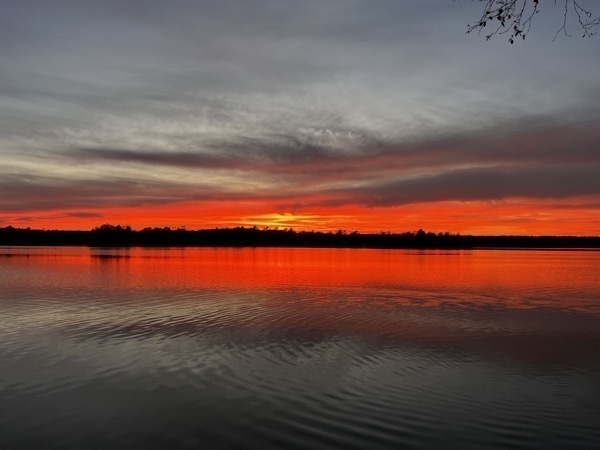
we built our cabin in Luck in 1999 as a place for our family to gather, and I’m happy it has worked out as a place where we gather with our kids and grandkids when we are around. I’m also really happy that this is a place where our kids and their spouses and children gather without us when we are avoiding the cold and enjoying California.
My Career
I’m thankful that I love what I do, and that I control my own schedule. How many people get to do what they love, and get paid for it? How many can do it on their own time schedule? I am the main person behind Runestone Academy, and every day I am helping more than 60,000 students learn math and computer science. But I can still play golf in the mornings with my friends, or ride bike, or play pickleball, or just have a cup of coffee and read the news or watch soccer or do the crossword puzzle.
Our Friends
I am thankful for our friends! Oh! I am so thankful for our friends! I do not even want to start this! But this guy and his wife are our oldest and dearest friends. College roommates, God parents to our kids, travel companions, you name it. This picture was taken on our 30th anniversary trip together. We take a trip every 5 years (sometimes every 4 AND 5 years) to celebrate our anniversaries. I feel like this is such a wonderful and unique tradition.
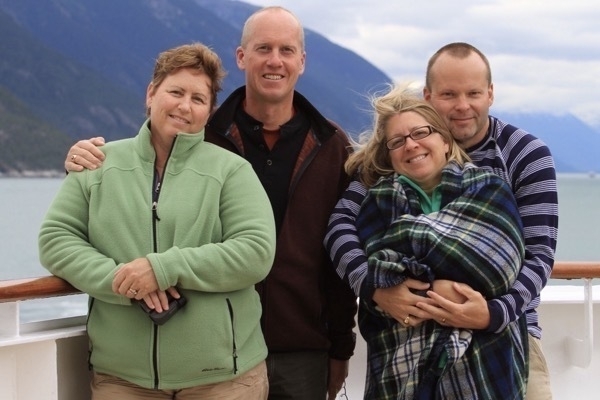
I am sorry that I have not named everyone that is important to me. That list and post would be much longer. I just started this post on a lark, and have only now realized the gravity of (not) naming everyone. I hope you know who you are and how important you are to me.
The danger of a post like this is that ten minutes from now I will think of something or someone that I missed. I am so sorry!
Westward Ho!
Instead of camping our way to California this Fall we decided to make it a four day drive. We stayed in, gasp, hotels! This is really our first driving trip where we have used hotels since the pandemic. The verdict? Its nice to pull your accommodations with you!
Our first night was a very nice lodge in Spearfish Canyon South Dakota. Although the lodge was nice it was kind of a bummer because we had a nice hike planned, but I had injured my foot just a couple of days before we took off and I couldn’t walk more than a few yards without a lot of pain.
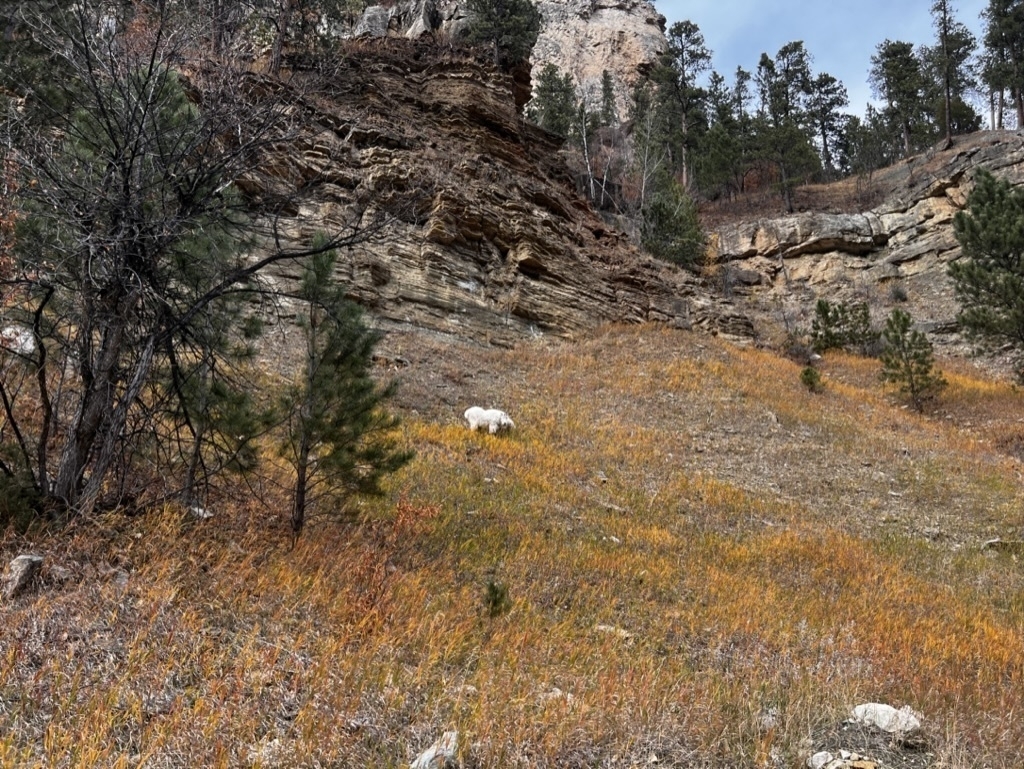
We did see some pretty cool sheep on the hillside!
We left at O-dark-thirty on day two of our adventure and had the pleasure of scraping ice off our windshield for the first time in a very long time! Today’s drive would take us across Wyoming to a lodge just outside of Dutch John Utah. The area is better known as Flaming Gorge. It was very pretty but our lodge was quite remote and felt even more so because we were clearly in the after season. Only one restaurant in the area was open.
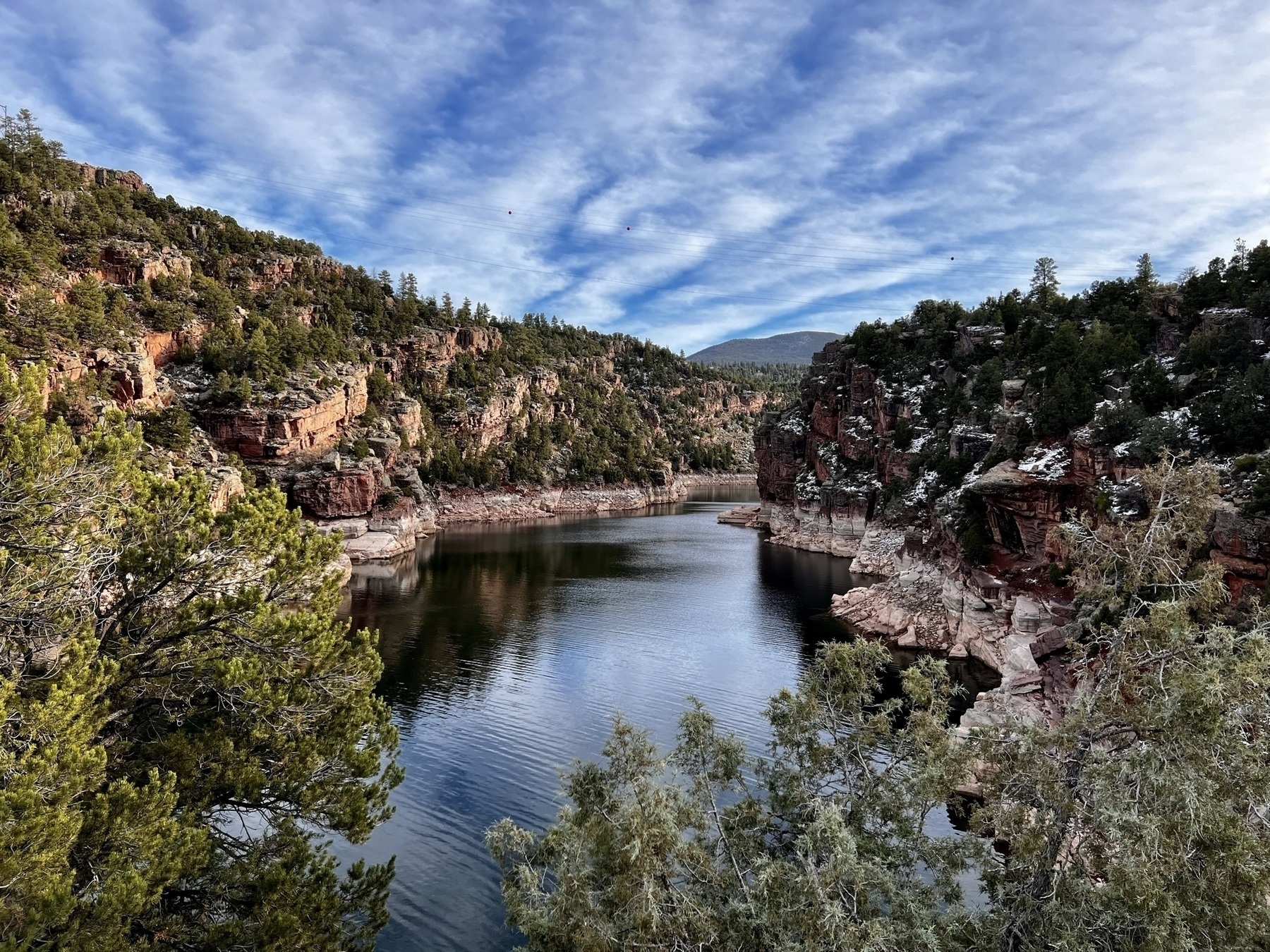
Even thought it was isolated, we had a very pretty view out the picture window of our cabin. Here is a nice Sunset shot!
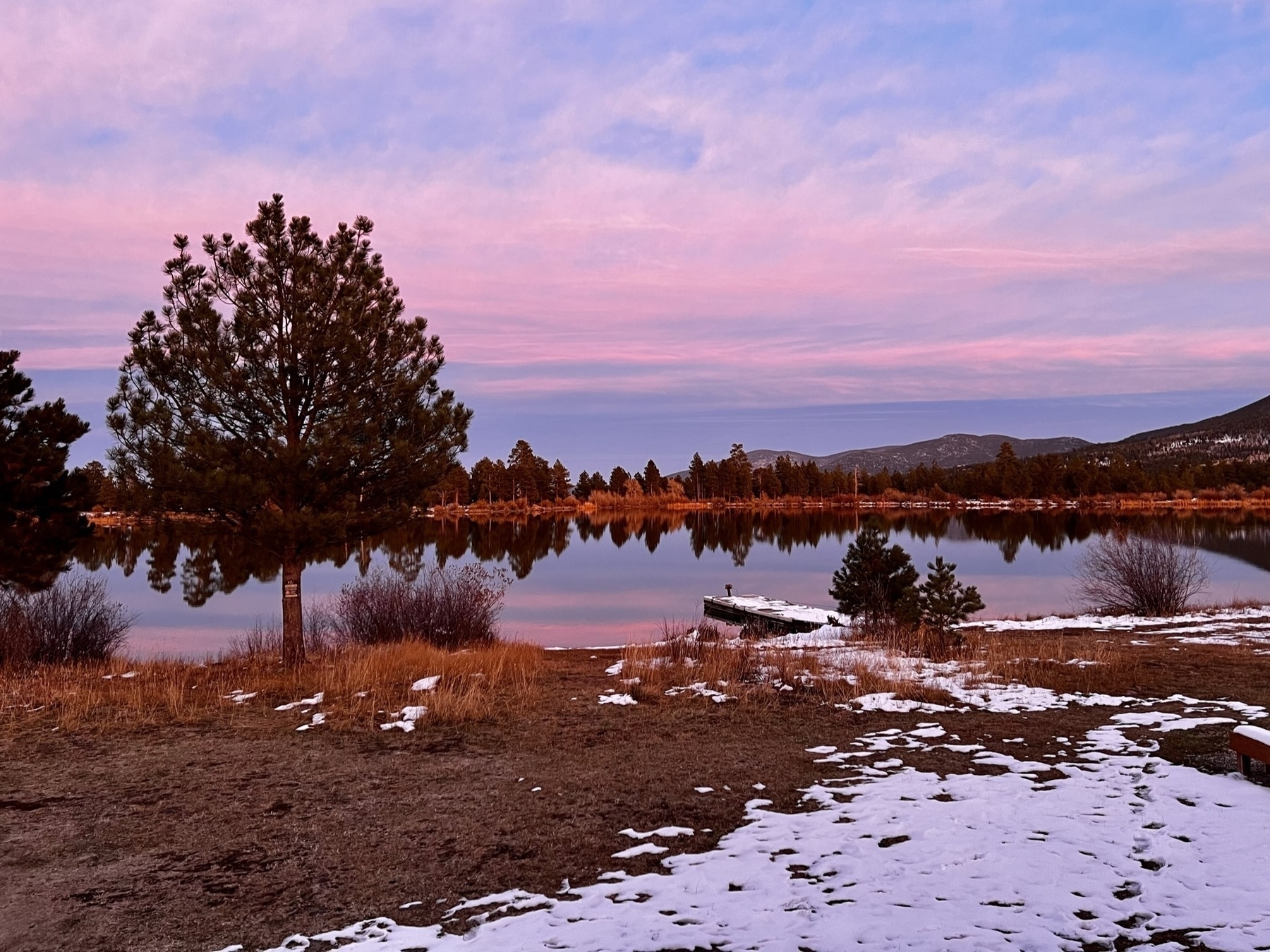
And to follow up, here is a sunrise photo from the same spot.

A long drive down I 15 brought us to Cedar City Utah for our third night. We headed up to Brian Head, a ski area and did a short little hike. My foot was feeling better by this time, but we still didn’t want to do too much. I love this shot of the show against the beautiful red rock! Our hotel was a Baymont tonight, and I’m not sure why, but the hotel had a some special “mini-rooms” even the door was about 3/4 of a normal width. This was our room for the night. The saving grace for the hotel was that it was near a brewery and a really excellent pizza place! I had a chicken pizza with white sauce and pistachios! Truly amazing.
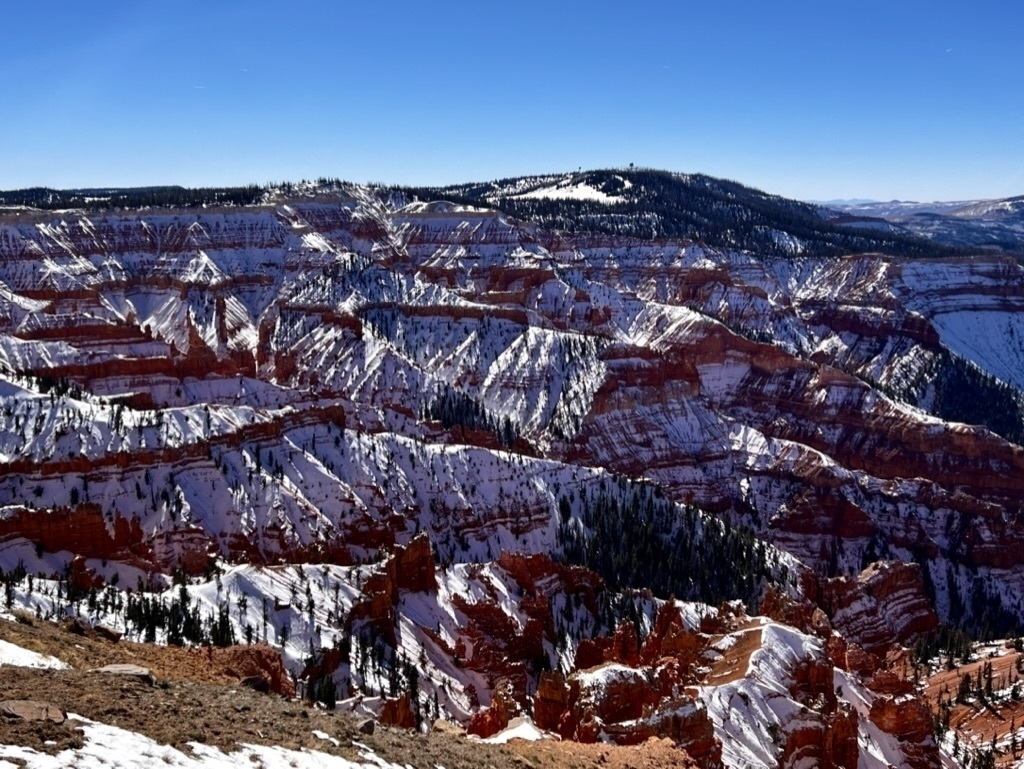
Our last day was the final push to Indio. But we made a quick stop at Kolob Canyon to take a short hike. Maybe some of the most spectacular views yet.
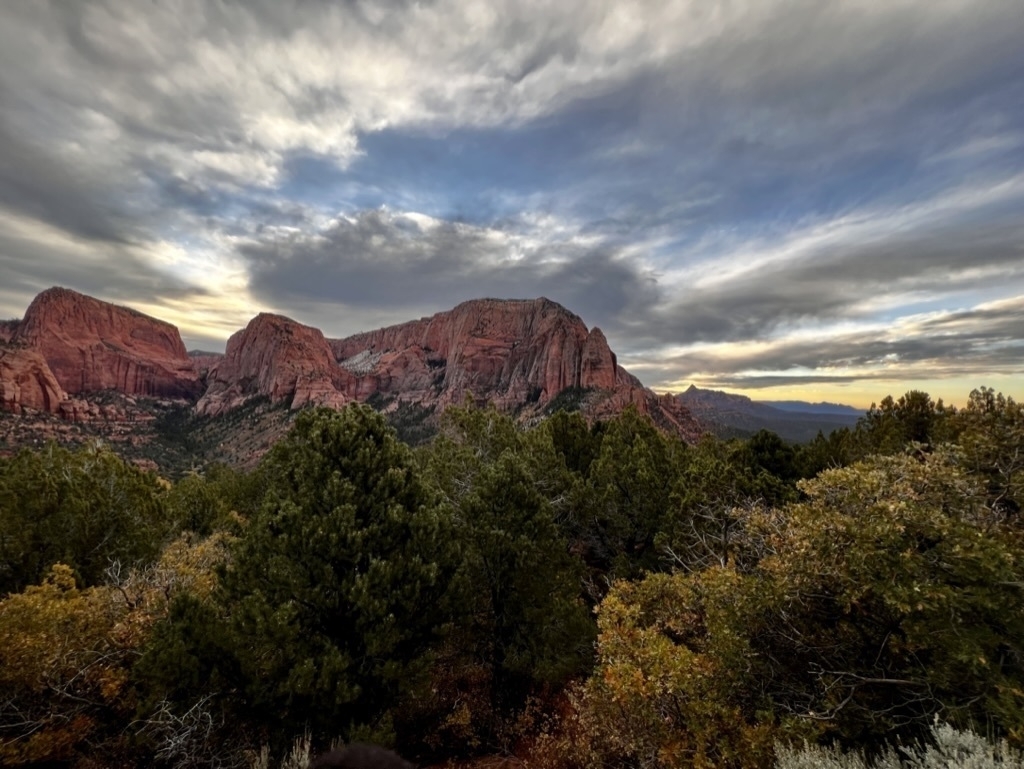

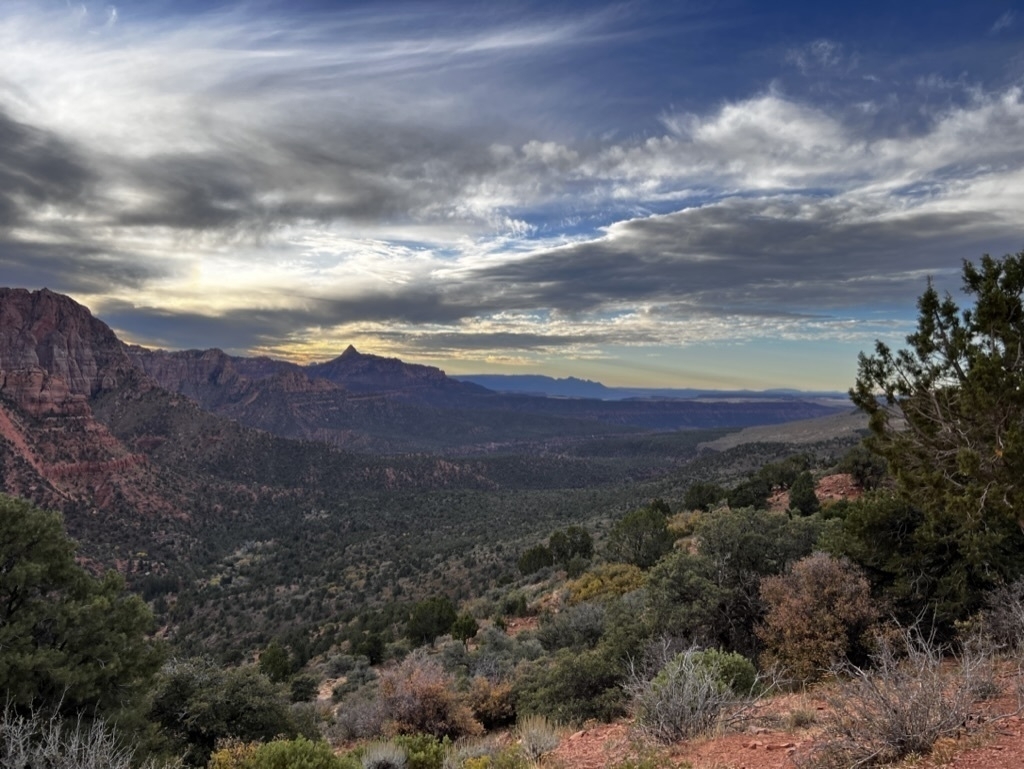
This was a great way to do the trip out this year. We averaged about 6-7 hours of driving a day with time at the end of each day for a short hike or some site seeing.
Superior Fall Colors
Timing the fall colors is a tough game to play. It’s hard to predict when they will peak because there are so many factors at play. Jane did all of the research and tried to make a reservation for next week, but could not find a good campsite. So we reserved for this whole week thinking we would use part of our reservation. Then I found out I had other commitments at the end of the week so we had to push our time further forward.
The results speak for themselves.
We arrived on a very gloomy and rainy Sunday afternoon. But discovered our campsite was just 100 hundred yards or less from the shore.
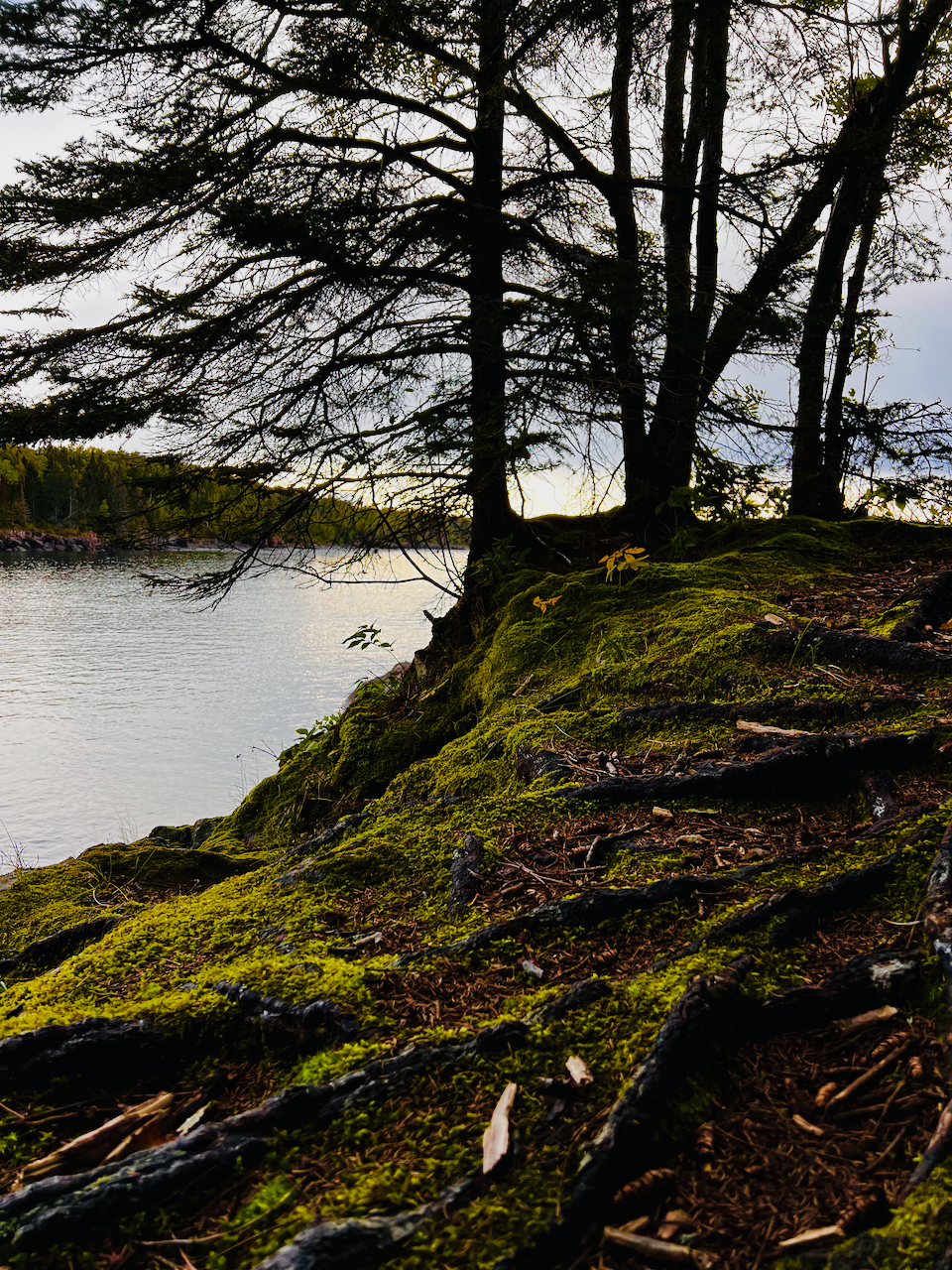
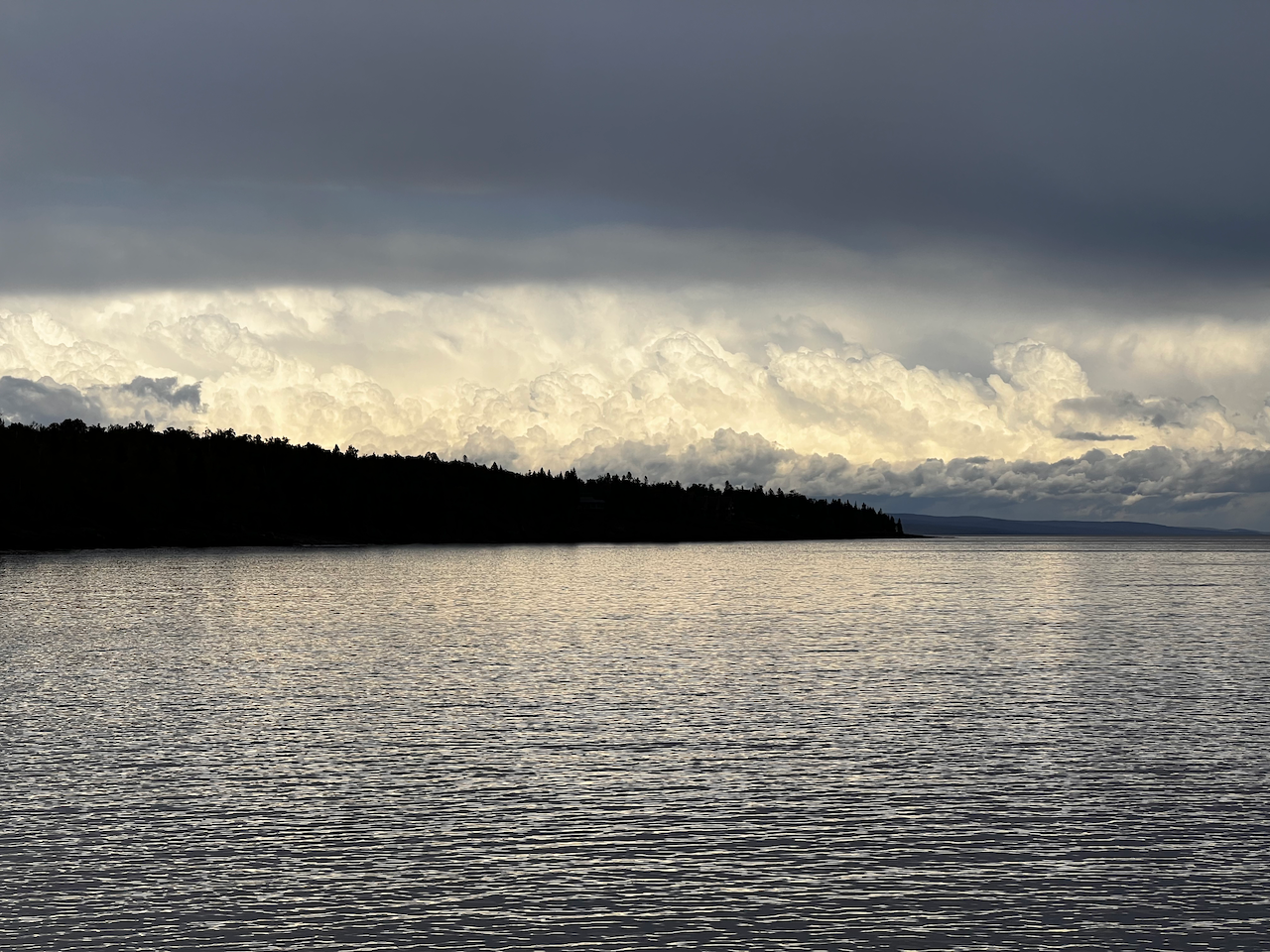
Bean and Bear
The next day was cool and clear so we did the 7.5 mile bean and bear hike near silver bay. The colors we almost there but not quite. Still it was a very beautiful hike, although Jane lost her Yellowstone hat from the vantage point where we took this photo.
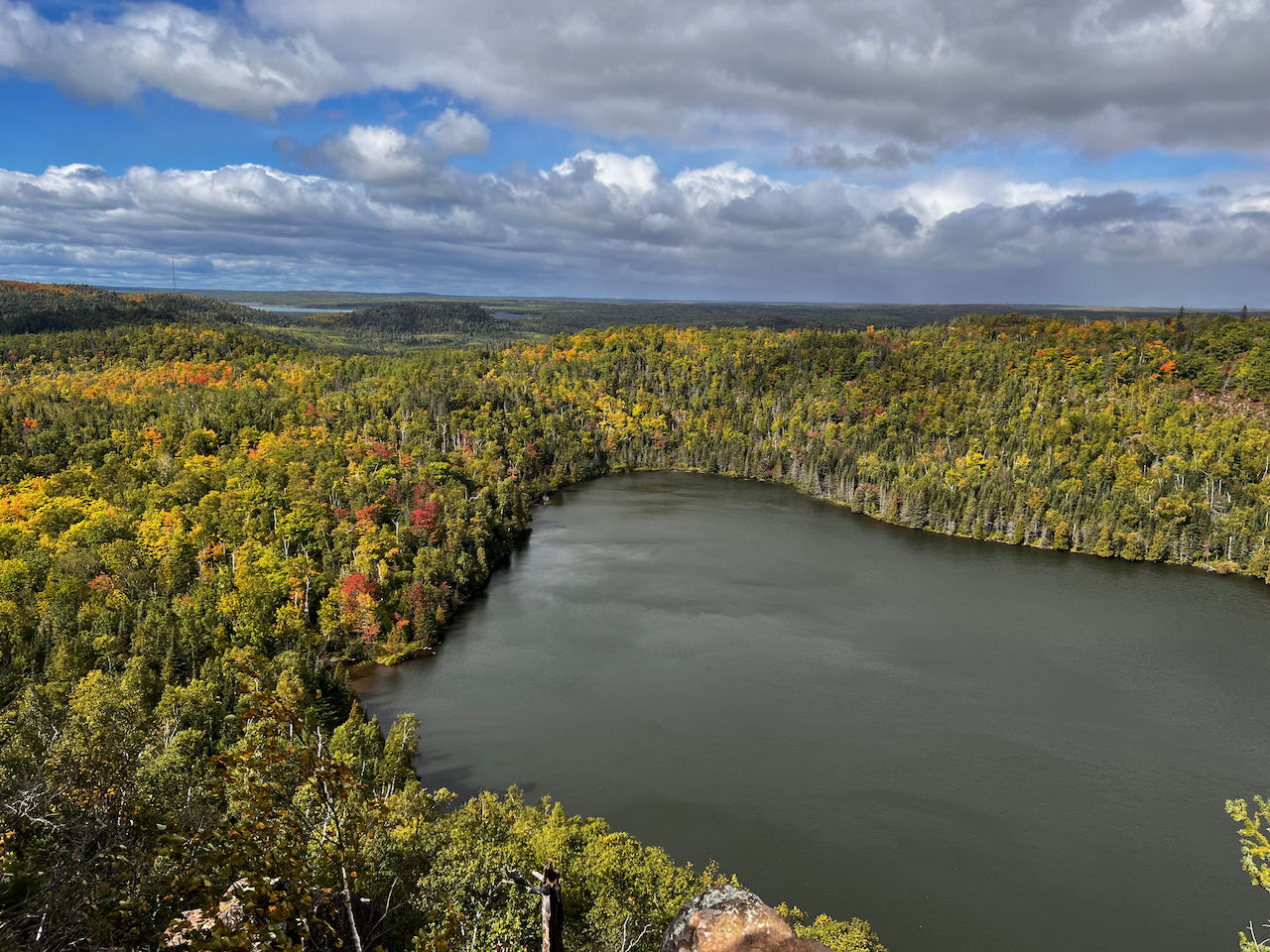
Oberg
A shorter hike on another clear day, but further north near Lutson had amazingly vibrant fall colors.
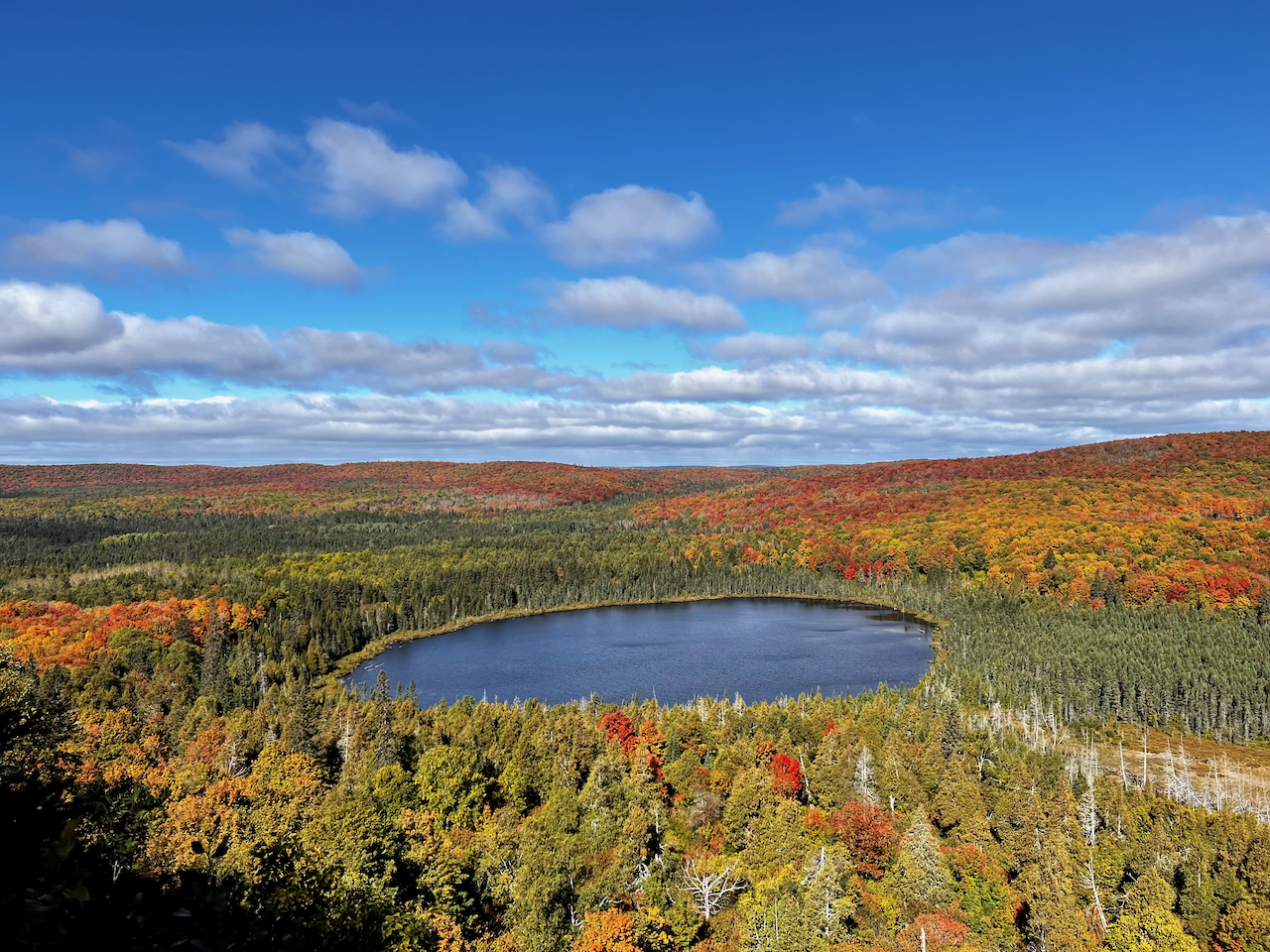
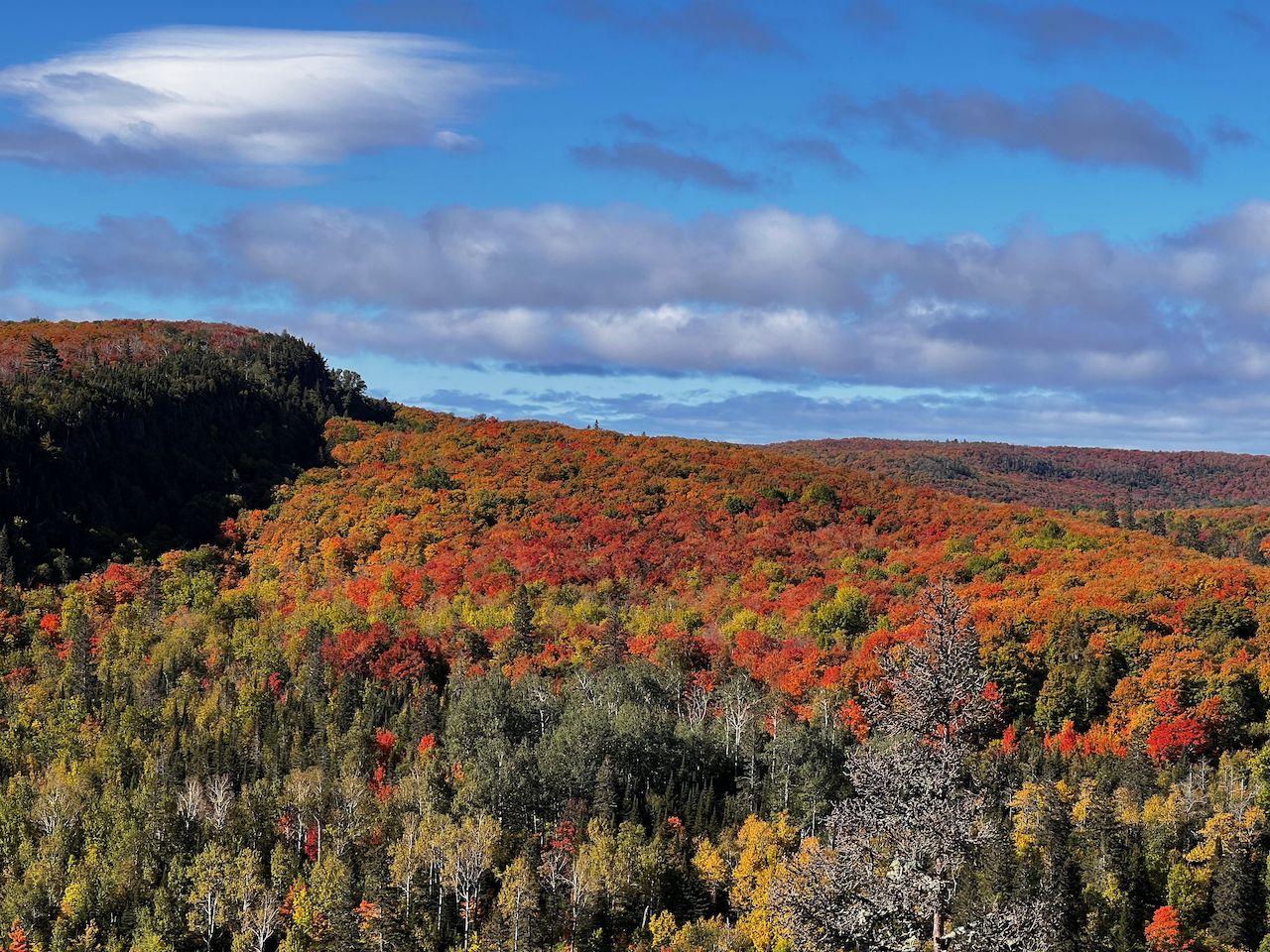
Temperance River
On our final morning we took the short hike to the Temperance River gorge. It had a beautiful waterfall, and we enjoyed watching an Arctic Loon try to fight its way upstream.
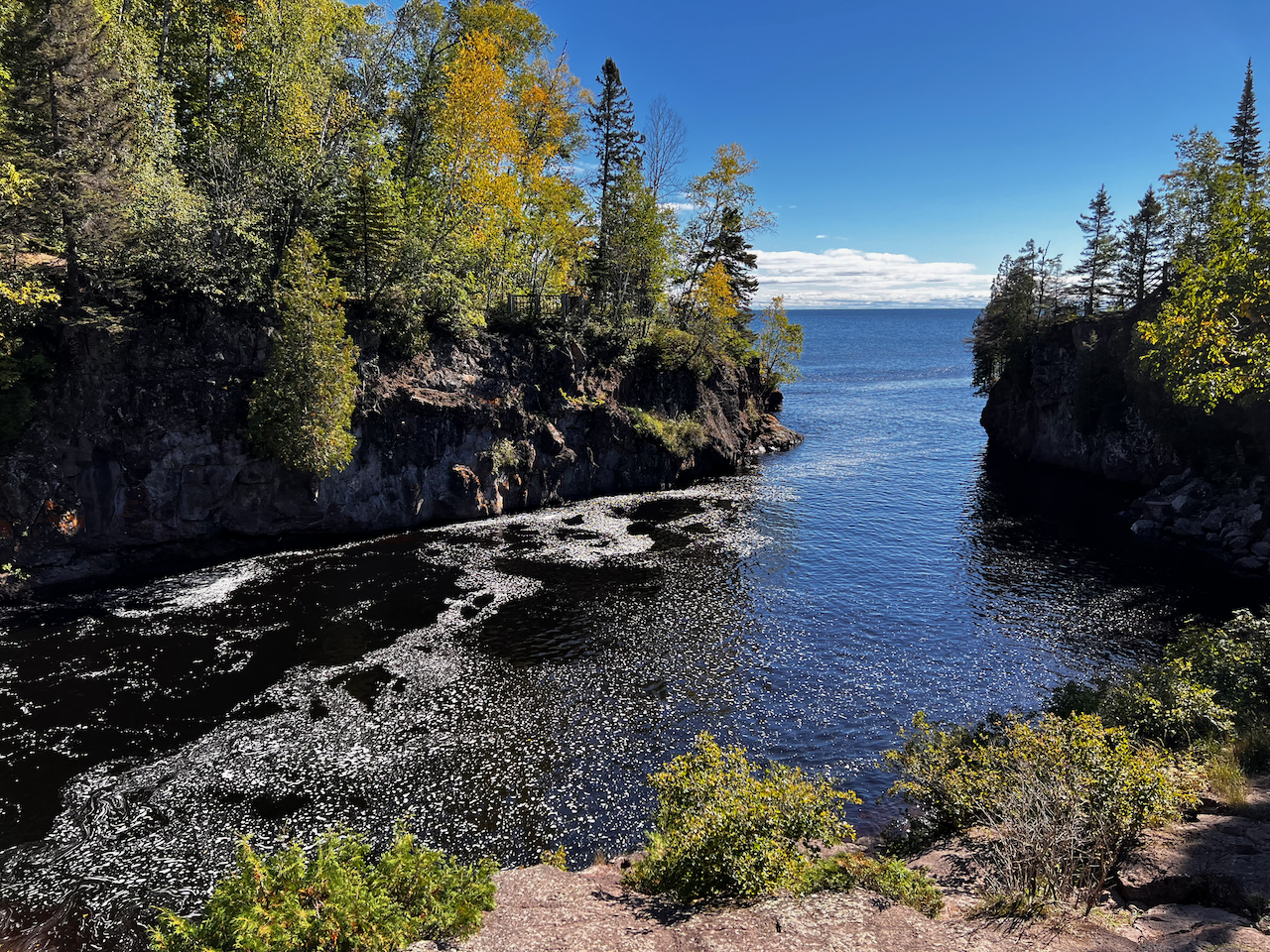
Fall Walks on Bone Lake
After a couple of years of taking long camping trips during the month of October it has been wonderful to be at the cabin for the “Fall colors” this year. These pics just highlight the everyday beauty of the area during October.
Its a bit cold to bike (40 degrees) but it is a nice temperature to walk. Here are a few photos that Jane and I have taken in the last two days on our walks around the cabin. Enjoy!
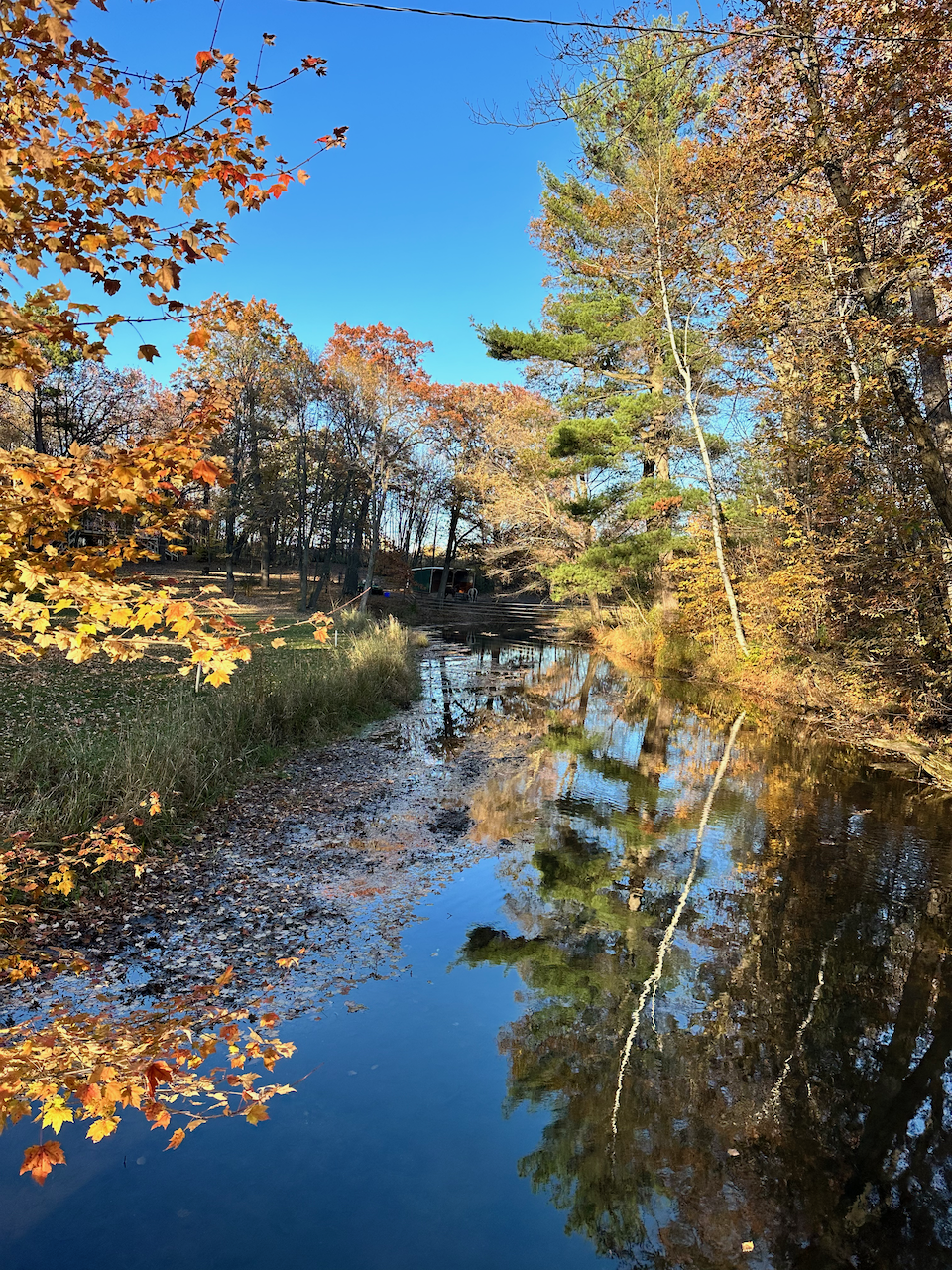
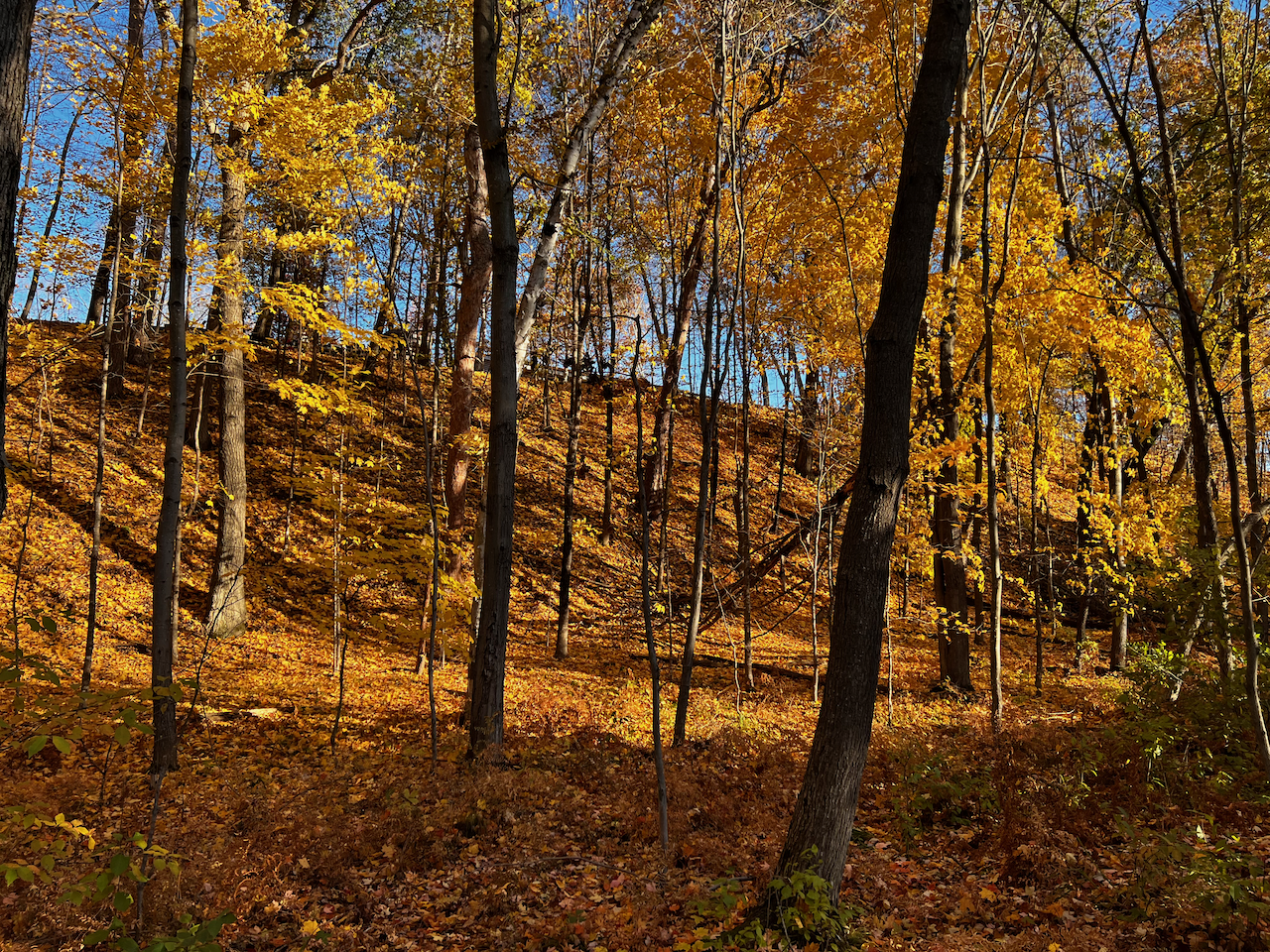
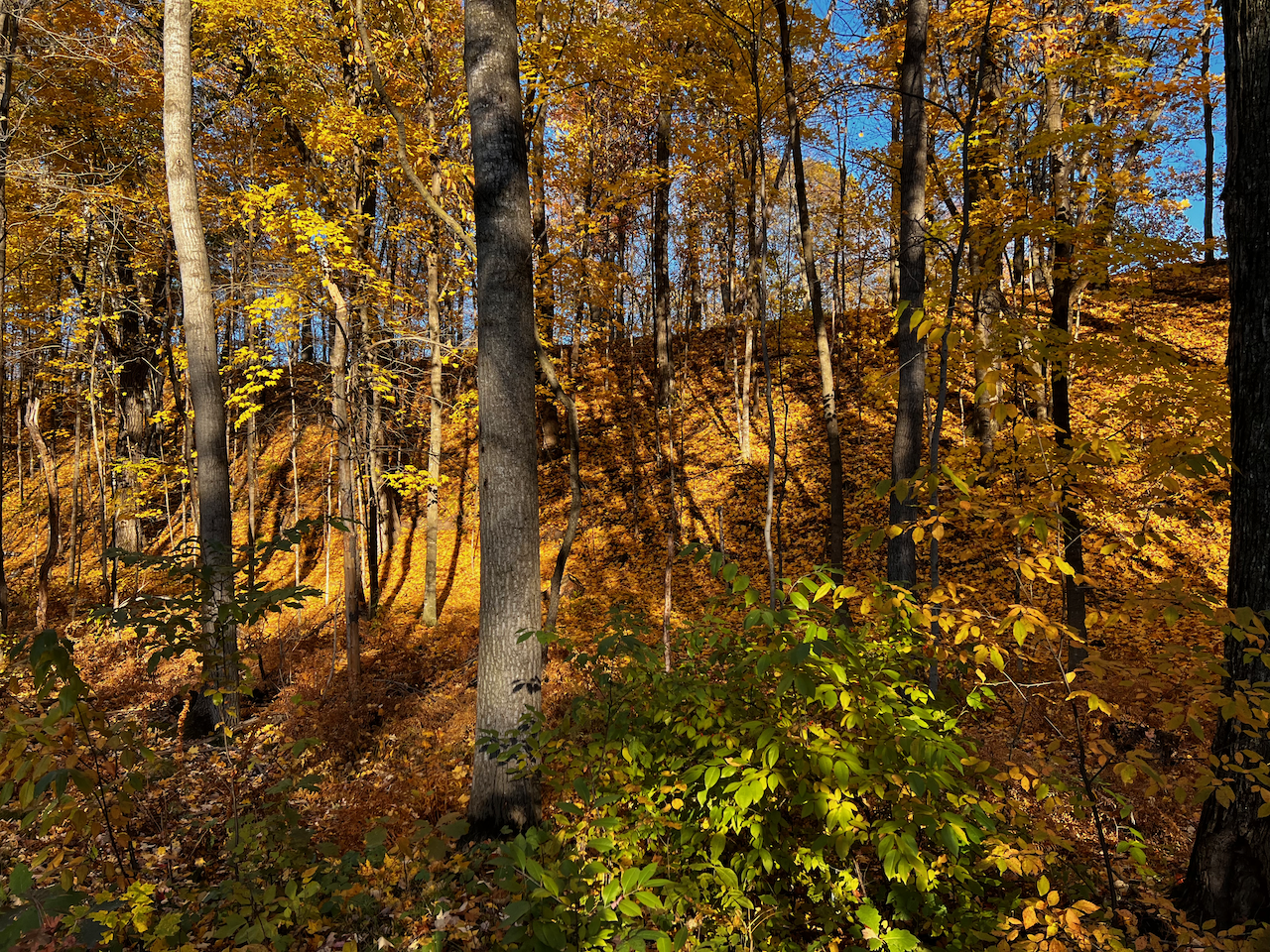
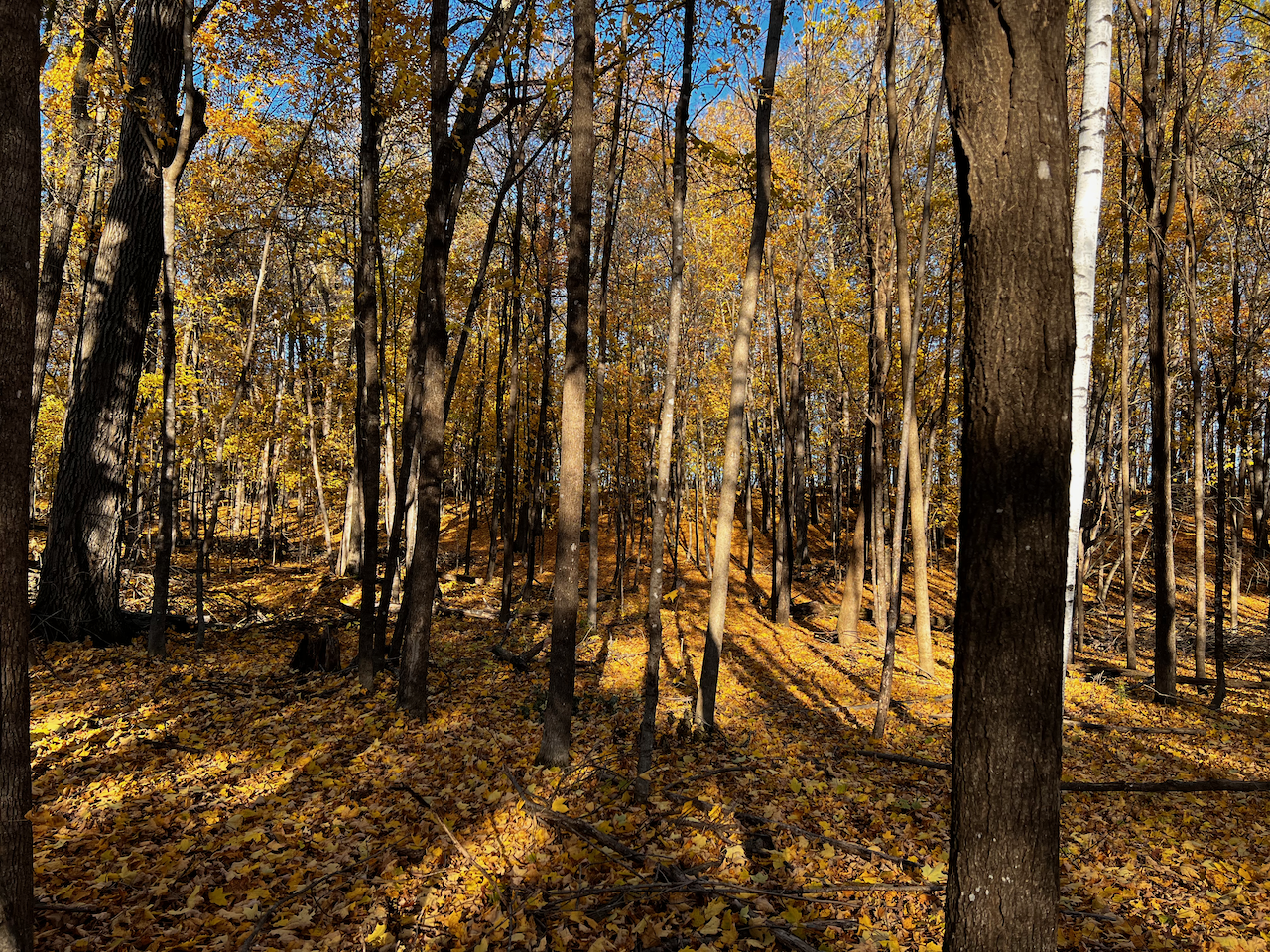

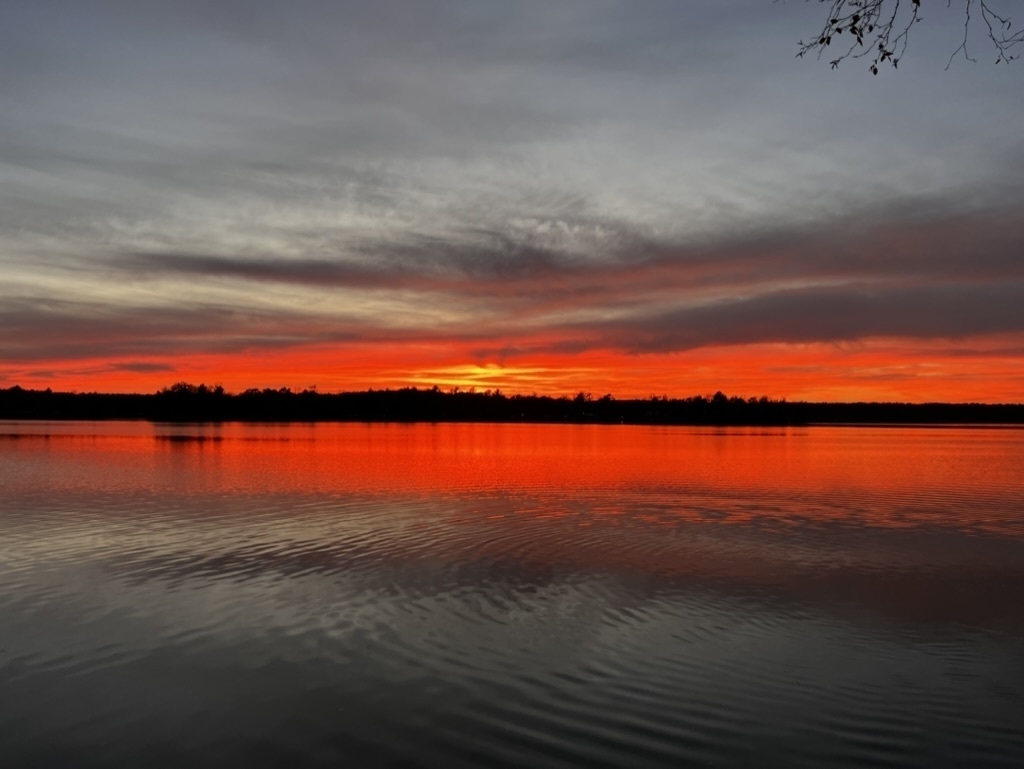
Devils Tower
The road home runs through Devils Tower National Monument. A monument who got its name from a misunderstanding between the Native Americans name “Bear Lodge” and the white people.
Nothing about this tower says evil/devil. But apparently after the army slaughtered all of the bison the area was a stinking pile of carcasses and the army colonel described it as Devil’s Tower. There is a movement to change it back, predictably opposed by Wyoming members of congress. You can read more about it on the park service website
As is our usual practice we spent the last night on the road at a KOA so we could have a nice easy way to clean out our tanks for the long trip home. This KOA shows a movie every night — Close Encounters of the Third Kind. You may remember that this monument featured in that movie.
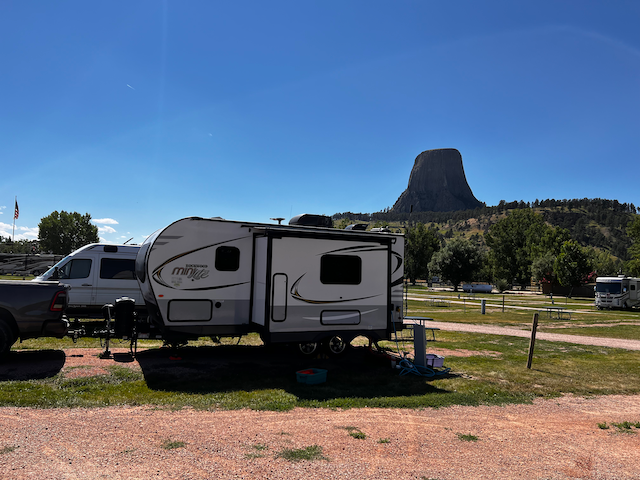
This is a popular spot for climbers. Except for the month of June when it is not open for climbing out of respect to the Here are some climbers coming back down.
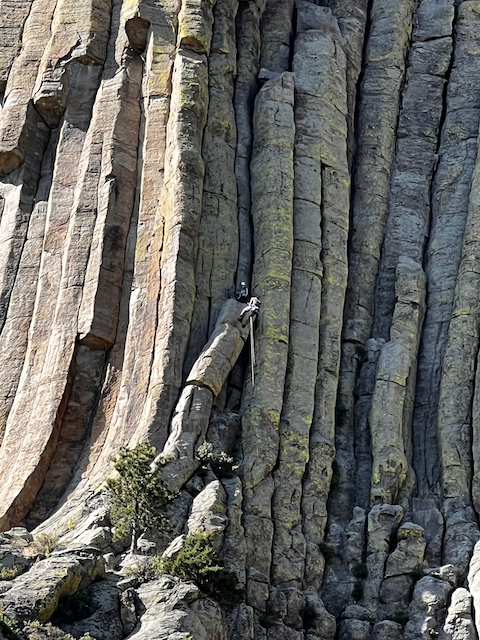
The title picture for this post was taken at 6 AM as we pulled out of the park to being our 13 hour journey back to Wisconsin. This was a fantastic trip, made even better by our traveling companions. Where will we be five years from now? Who knows, but it will be an adventure.
Yellowstone Scenery
Although there was a huge flood in Yellowstone just over a month ago there was very little of the park that was closed to visitors. We took full advantage of that and saw everything that the park had to offer. When most people think of Yellowstone, they probably think of Old Faithful, but there is so much more to the park than that. We did a few longer hikes, and a lot of short hikes. We saw beautiful rivers and waterfalls and canyons. Even the meadows along the river were amazingly beautiful. I am very grateful to the Hayden expedition, congress, and to President Grant for making Yellowstone the first national park in the world.
The grand canyon of Yellowstone was really grand, and maybe my favorite of the trip. There are two huge waterfalls, upper and lower. Here is a view of the lower falls — which are 308 feet tall! For comparison Niagara is 167 feet but Iguazu falls are 360. I looked it up so you get to read it!
We started out our visit to the grand canyon of Yellowstone at artist point, supposedly named for some paintings made by the artist Thomas Moran who was part of the Hayden expedition. Moran painted the falls to present to congress because after discovering Yellowstone they knew that it needed to be preserved and wanted to persuade congress to preserve this place for future generations.

But this is a mistake, he actually made the paintings from the north rim. Nevertheless its a great view point and you could definitely be inspired to paint there.
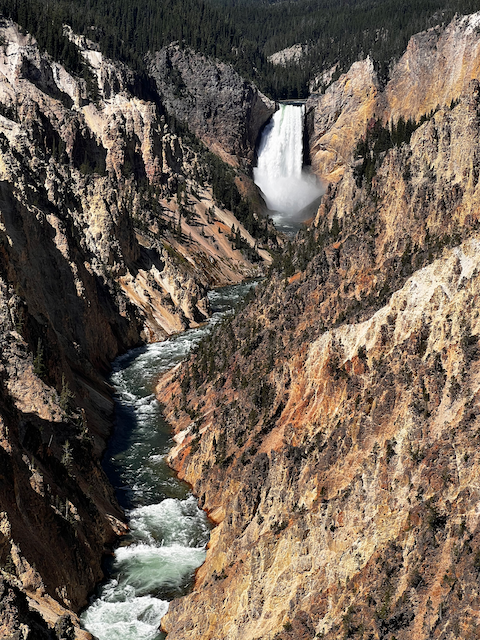

From the north side of the canyon You can take a 3/4 mile hike down to the brink of the upper falls. Its a 600 foot elevation change but you get to stand and look right over the falls.
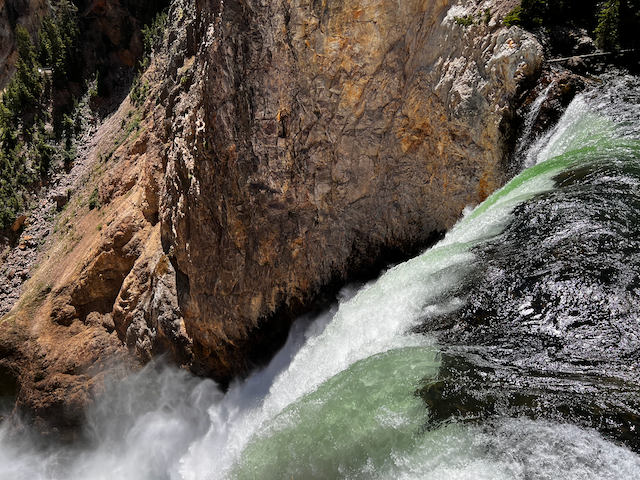
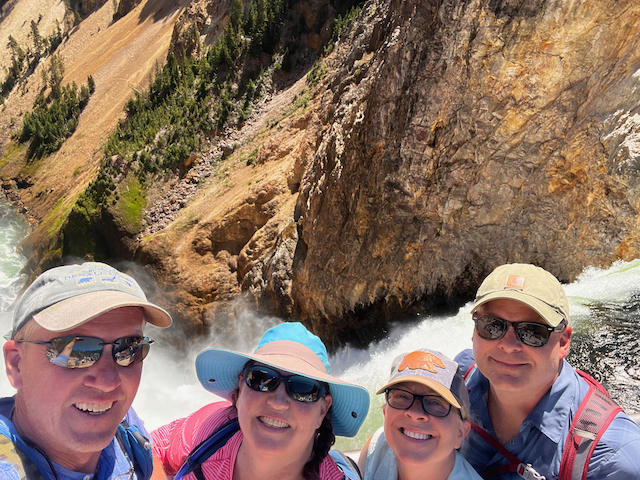
Sometimes you can happen upon something really nice just by taking a short little offshoot of the main road. These are wonderful stops without the crowds that you see at some of the main attractions.
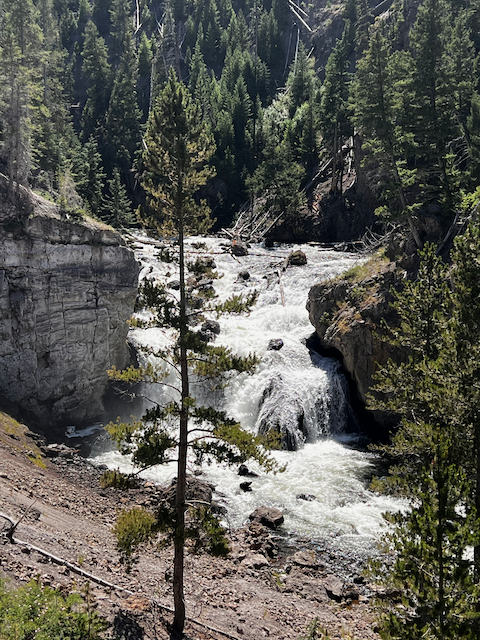
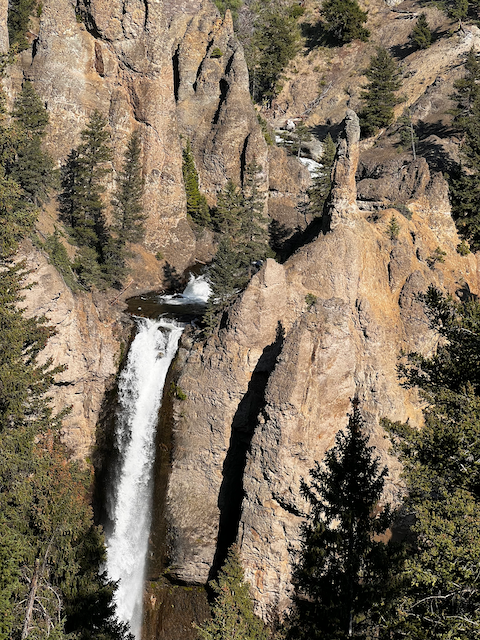
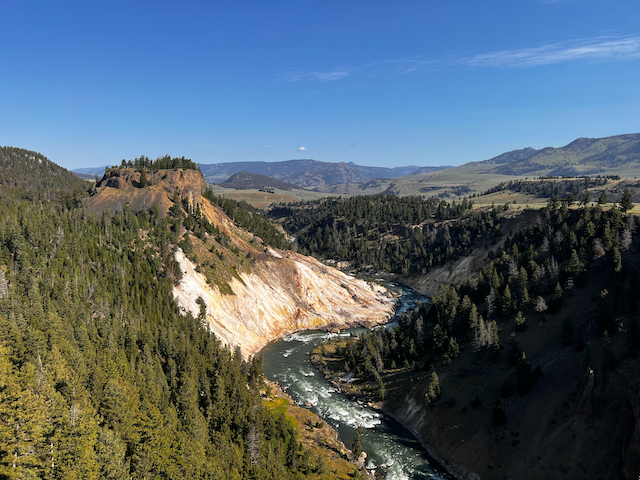
This has been a wonderful trip. Tomorrow we leave Yellowstone and begin the two day trek back home. We will make a stop at Devils Tower tomorrow night, and then have a marathon day back to the cabin in Wisconsin on Friday.
Mud Pots, Hot Springs and Geysers
Educational Post Alert (EPA)! Did you know there are four kinds of geothermal features in Yellowstone? And that Yellowstone has more than half of the worlds geysers ? Thats geysers not geezers , although there are a lot of geezers here, I’m pretty sure its not more than half of the worlds population.
The first couple of days in the park we visited a lot of thermal features I’m going to take them by feature rather than going in order. We will go from most boring to least boring. As a bonus for sticking with us you will get to see wildlife photos.
Let’s begin with Fumaroles. You might think these sound like some nice Italian pastry stuffed with sweet cream filling, but you would be wrong. Fumaroles are gas vents. And when I say gas I mean sulfur gas. You can encounter these things all over the park and you usually see them and hear them before you actually get to them.
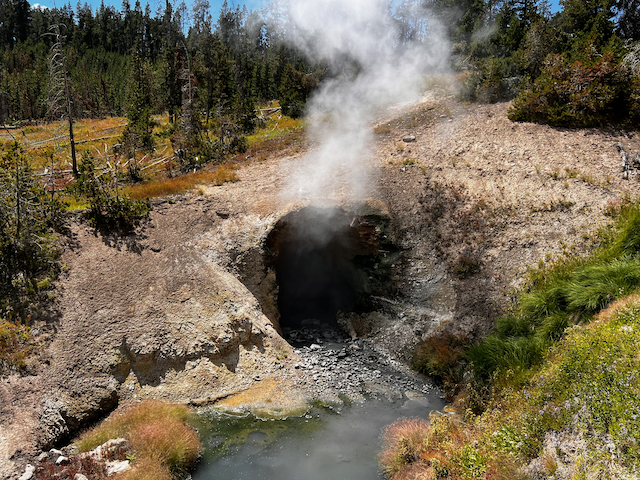
Next on the list are the mud pots. Mud pots are boiling pools of, well, mud. In the springtime when there is more runoff and rain they tend to be kind of thin, but by late summer and early fall they are very thick and muddy. These are also quite odiferous, but kind of fun to watch them bubble away and spew mud into the air.
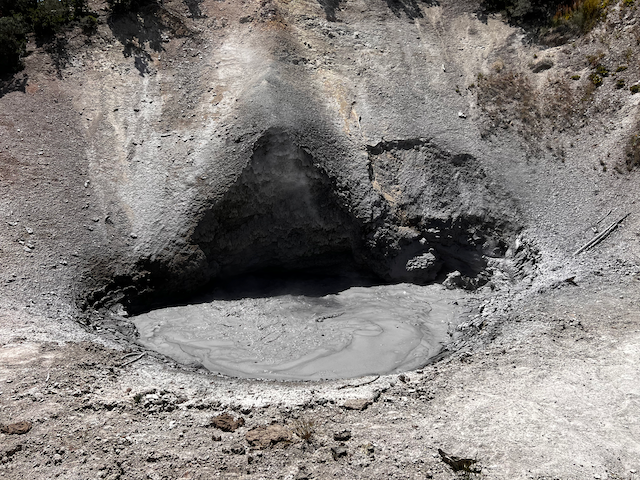
Third are the thermal pools. These can be quite beautiful actually. They look like they would be wonderful to sit in like a hot tub. But they are actually way too hot for that and their PH is quite acidic. They also contain lots of interesting kinds of bacteria that only grow at higher temperatures. In fact the colors in these pools are from mats of bacteria that thrive at different temperature levels. Not only are they pretty, but they are scientifically useful in that they help make DNA replication much faster!
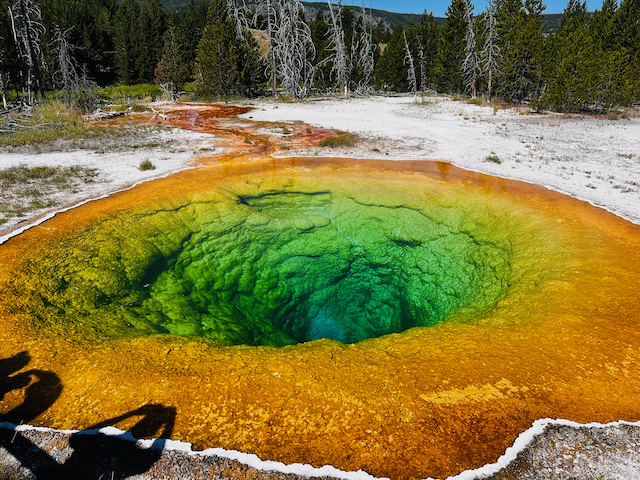
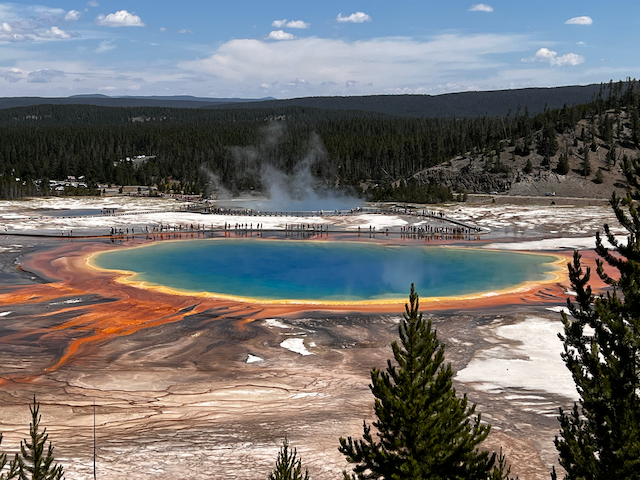
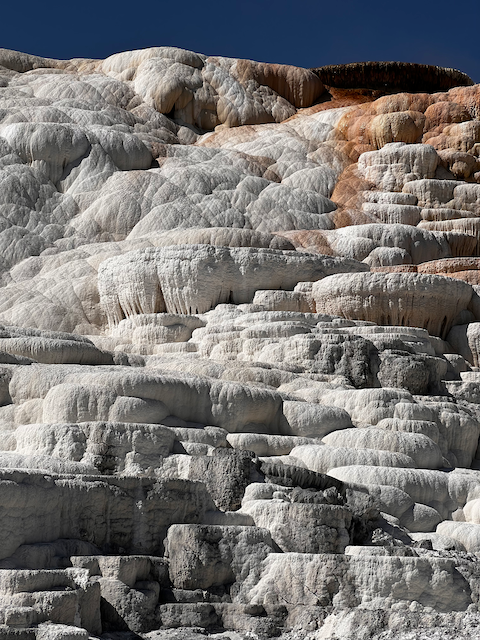
This pool deserves some special mention. It is right in Lake Yellowstone. It gives anglers the option to catch their fish and cook it without even taking it off the hook. It is called the fishing cone.
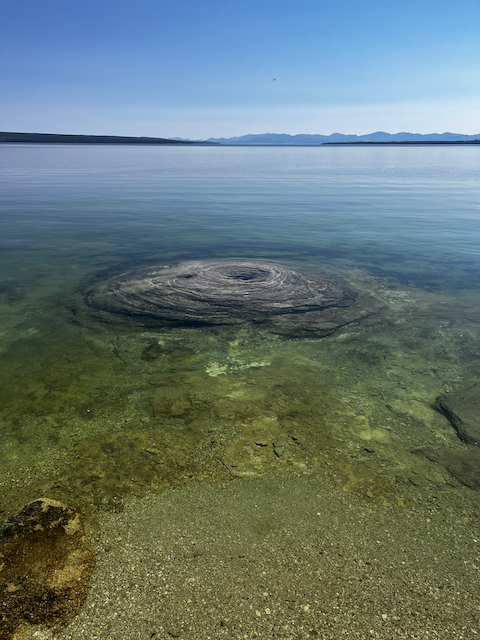
Finally, the most famous and dramatic of all of the features are the Geysers. Geysers are especially fun when they erupt. Old faithful, here at Yellowstone erupts every 35 minutes to 2 hours. We enjoyed seeing old faithful twice, once from a viewpoint up on the hill quite a ways away, and the other time right up close. We also witnessed several other smaller eruptions and different geysers around the park.
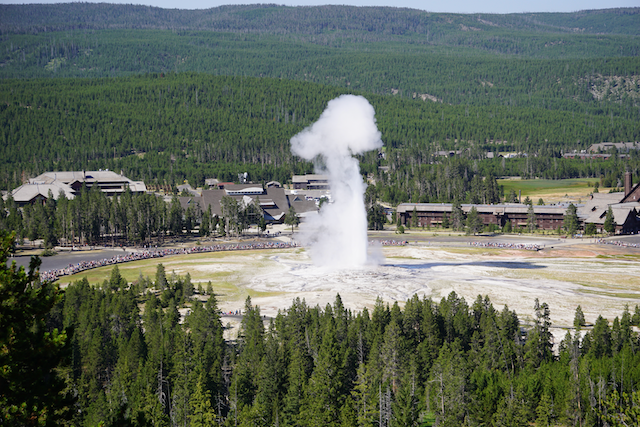
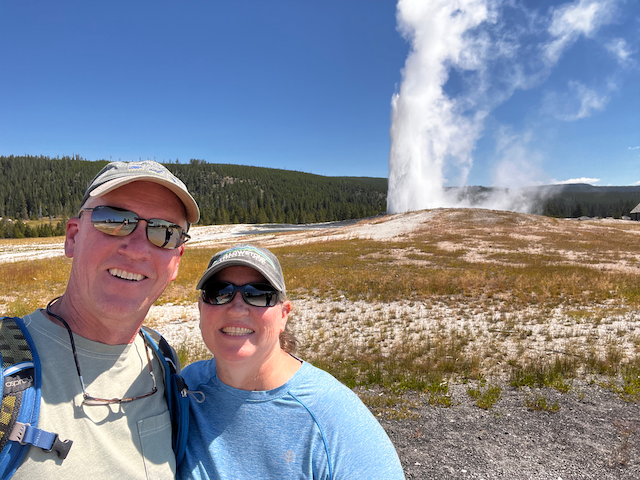
OK, you made it this far, here are some animals. By far the animal we have seen the most is the Bison. We have seen them in the field, near the road, on the road, rolling in the dirt, everywhere. We did not pet them. We also saw this nice herd of Elk in the distance. But no bears. We did get to observe some black wolves, but trust me they are so far in the distance that they don’t really make for sharable photos. We also saw a coyote out on the road in the middle of the day, which is quite unusual.
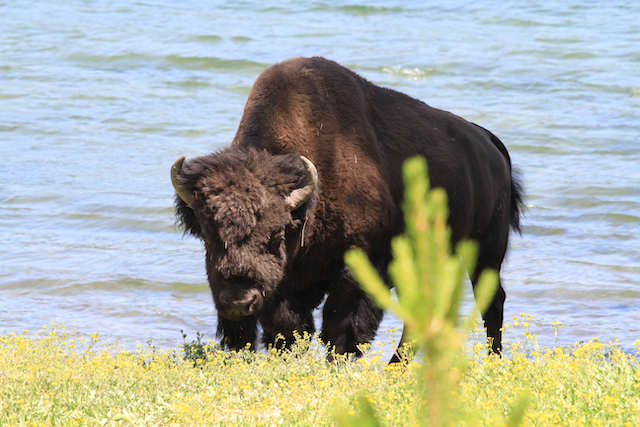
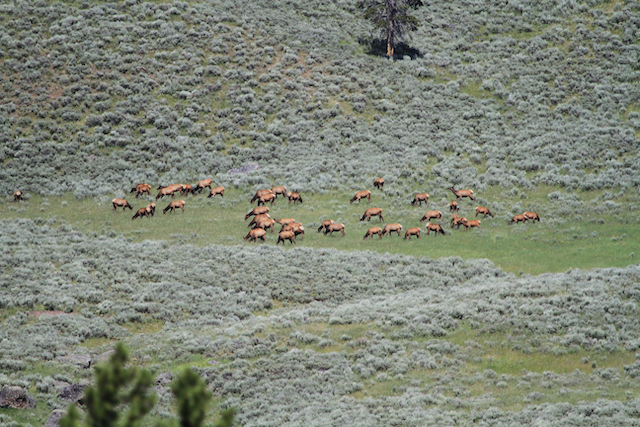
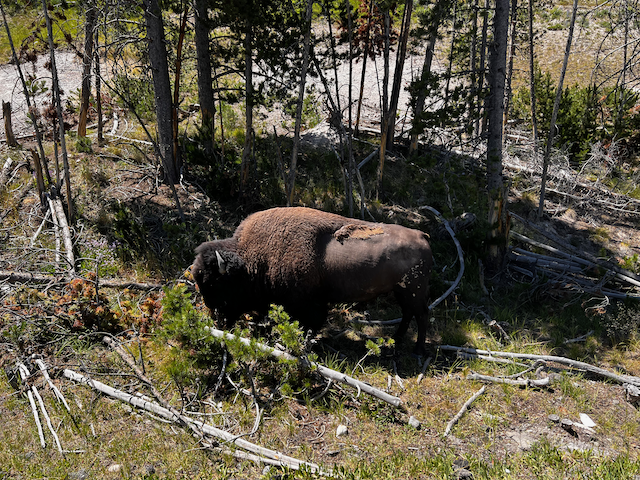
Grand Teton Icons
What do Oxbow bend, Schwabacher landing, the Moulton barn and the snake river overlook all have in common? These are all iconic sites to see in the park. We set out early again this morning to beat the crowds and the heat to see them all. Although today was not a day for long hikes we did enjoy several short walks to see the sites.
The first stop was an early morning stop at Oxbow bend. A great place to spot wildlife, but even though we were there early in the morning we didn’t see any mammals. The coolest thing we saw at Oxbow was an Osprey carrying off a trout to its nest. A trout is perfectly streamlined for flight underneath a bird of prey.
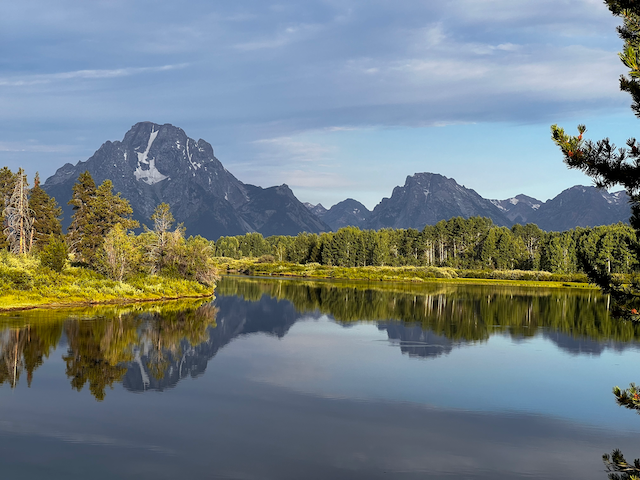
A little further down the road we had a fantastic view of Grand Teton in the beautiful morning light.
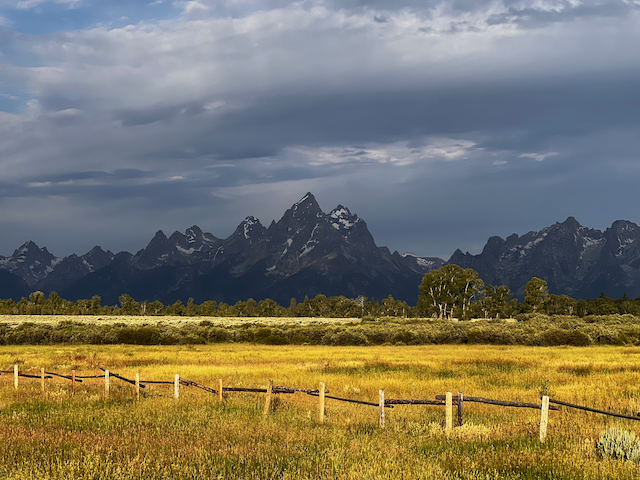
Our next stop was at the Snake River overlook. This is the place where Ansel Adams took his iconic photo that put Grand Teton on the map. There are more trees now than when he took the photo in 1942. We did our best to recreate the photo using 2020 technology and filters.
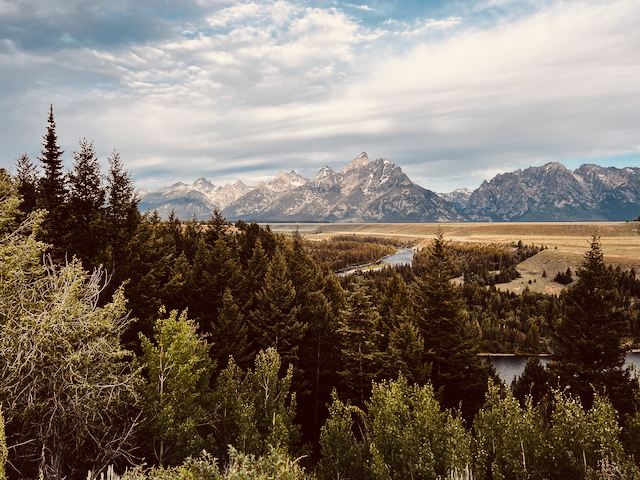
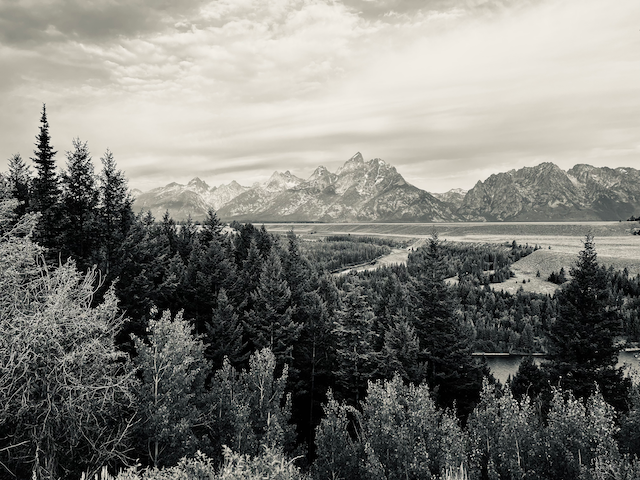
As we were heading to the truck we overheard one young dad tell his three kids “Look kids there are some iconic Grand Teton crows”. The only thing I can imagine that would inspire a statement like that was if they too had been listening to Gypsy Guide in the car.

Further on down the road we went, this time our stop was Schwabacher landing. We were in luck! There was a mama moose and her baby eating and drinking in the river. This time I had our good old Canon SLR with the long lens so we were able to get some really good photos of the pair.
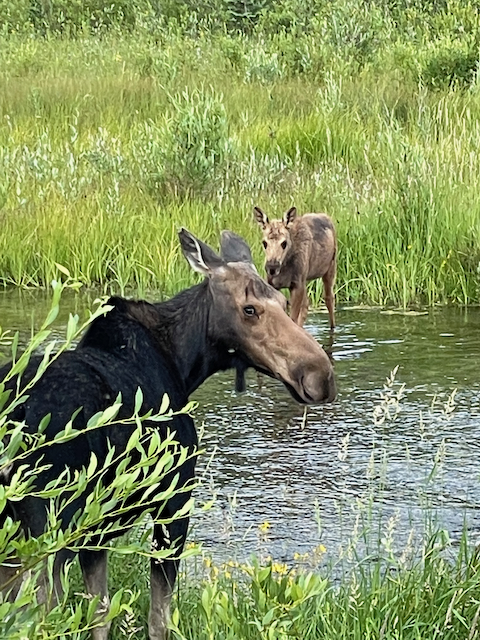
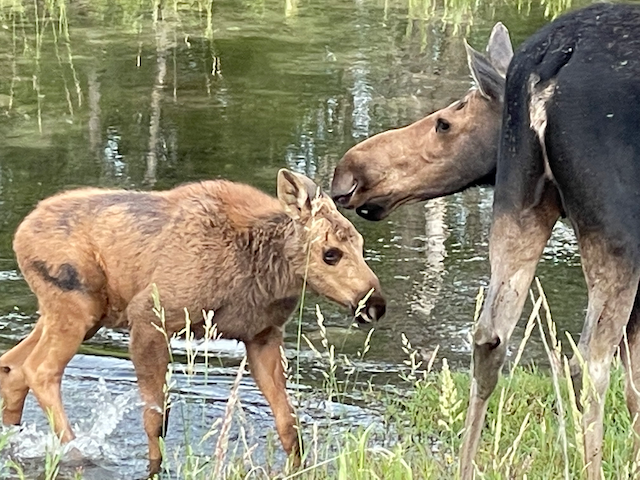
Once again we were really hoping to see a bear so we spent more time at a little more secluded pullout at Schwabacher but didn’t see anything but more birds.
The last of our iconic stops was on mormon row where there are some well preserved barns from the 1890s.
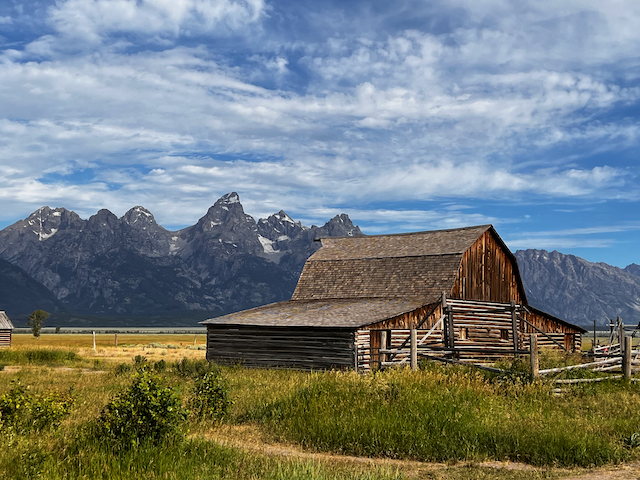
After seeing all of these iconic sites we decided to continue on into Jackson and wander around the town a bit. It was a Saturday so we happened to hit the farmers market for some great fresh bread. Other than that Jackson seemed pretty much like every other western tourist town.
Grand Teton - Cascade Canyon
The first ferry across Jenny lake leaves at 7am she said. We decided to shoot for the 7:30 crossing, which turned out to be a brilliant move. First we avoided lots of crowds, and second, we were up into Cascade Canyon in time to see a group of bull moose waking up!
One of the nicest hikes in Grand Teton is the Hidden Falls, Inspiration point, and Cascade Canyon combination. It is about a 480 foot climb for the first mile and then it evens out for the walk through the beautiful glacial canyon. By leaving early we avoided the people coming down the trail as we were heading up and it was generally a lot more peaceful.
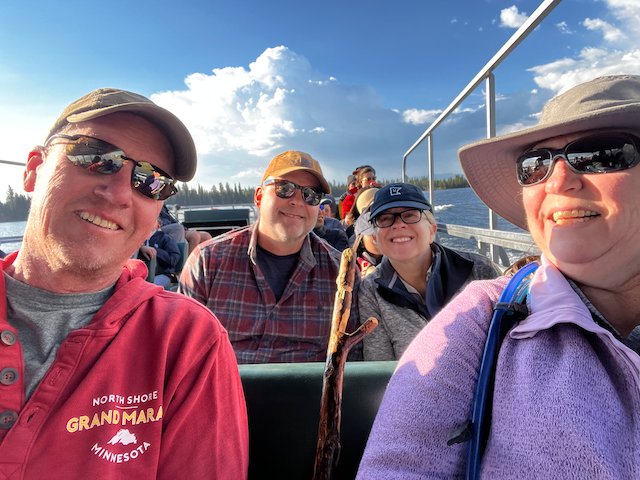
The first stop was hidden falls, a beautiful waterfall on cascade creek that feeds into Jenny lake. The lake temperature is 60 degrees at the surface, “but gets a little more chilly if you dive down.” Not much chance of that happening.
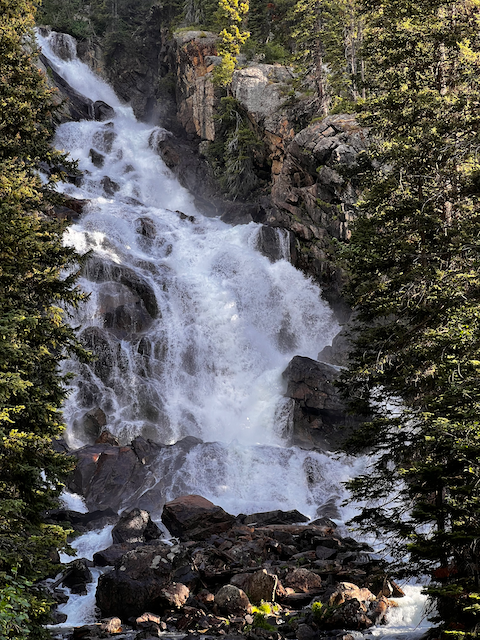
A further climb leads you to inspiration point. On the way up this climb there are a couple of places to stop and take in some of the peaks in the Teton range. Including this picture of Teewanot. The contrast of the morning sun against the storm clouds over the peak was awe inspiring already. And yes we did hear thunder, but thankfully we did not see or experience any lightning!
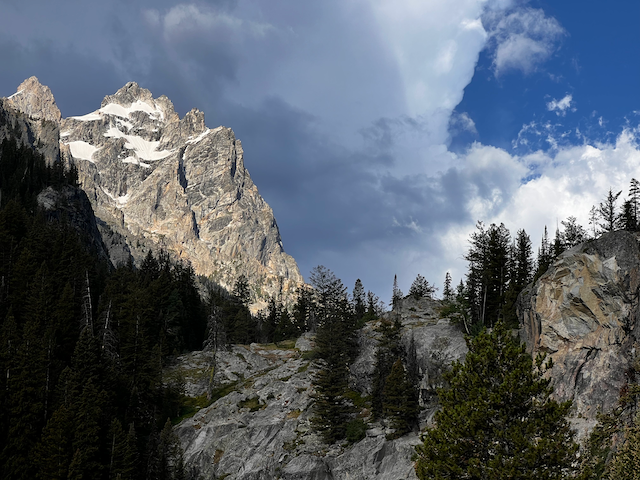
When you arrive at Inspiration point you have a fantastic view of the lake. I love this shot that shows the ferry leaving the dock leaving a feather-like wake.
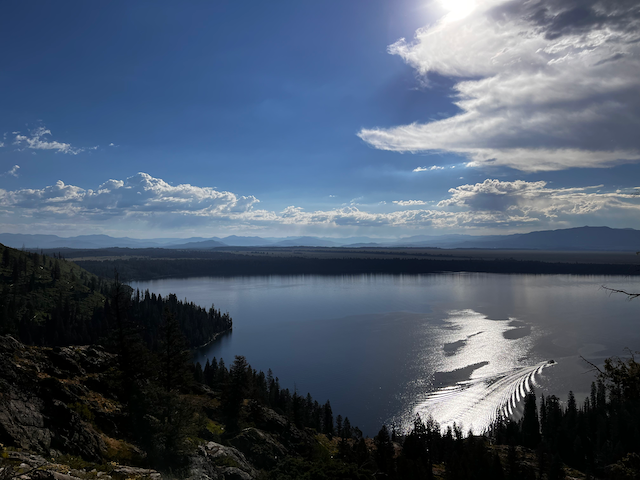
After inspiration point the trail levels out some, and so we were just enjoying a nice walk back into the Cascade Canyon. We caught a few raindrops as the storm clouds passed over us, but not enough to get wet. We happened to talk with a couple of guys coming down the trail who told us they had just seen a couple of moose laying in a meadow about 5-10 minutes up the trail. We were lucky enough to spot them when we arrived! It was a bit disappointing to see nothing but antlers, but It looked like they were beginning to stir so we decided to hangout a while and see if anything happened. During the wait we amassed a huge collection of very bad photos of moose antlers behind plants in the deep shade.
But sure enough after a 15 minute wait one of them stood up. This caused a second one to rouse itself as well. Eventually they ventured into some light bright enough to get a few decent photos. Although 99% of our photos are taken on iPhones these days we were glad to have brought along our old Sony A6000 with the telephoto lens to get a better closeup.
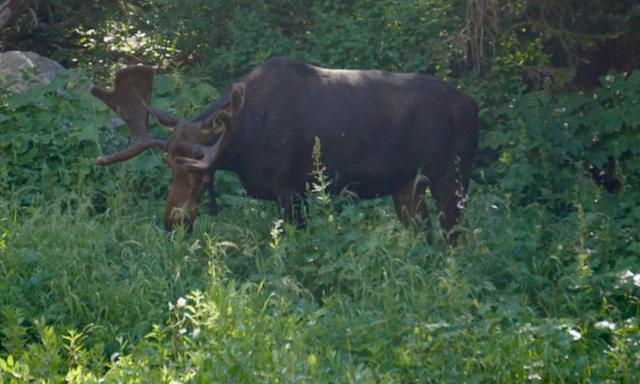
This little encounter reminded us how lucky you are to see wildlife while hiking along. The animals are so hard to spot if they are not up and moving. We often wondered how often we passed some kind of wildlife that was just quietly lying behind a bush a few feet away.
We continued further into the canyon now in hopes of seeing a bear (at a very safe distance). The closest we came to a bear was a surly teenager who ruined his grandma’s entire day with his behavior. A side note here - it seems that leaving early is a good strategy because it is mostly people our age on the trail and some families with younger happy children or cute babies in backpacks who get up early in the morning. We noticed a lot more teens on the trip down in late morning.
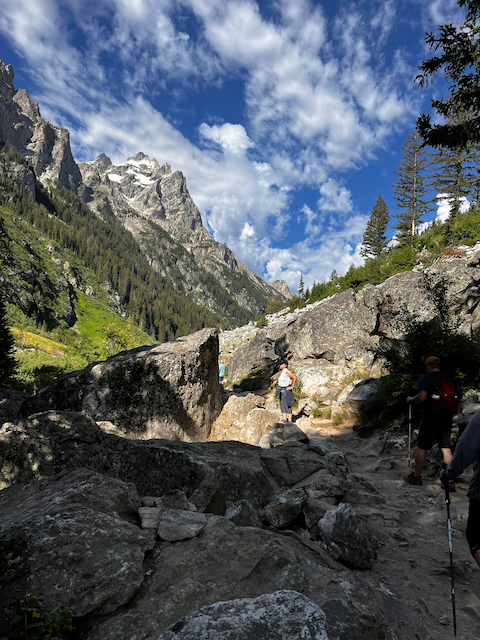
We arrived back at camp in time to make some lunch. I guess I really worked up an appetite because caesar salad with chicken never tasted so good. We voted for a lazy afternoon of reading, and checking out the beach. Around 4:00 we took a short drive up Signal Mountain to take in the views of the “hole.” Fun fact: The term hole was a common term to describe a high altitude valley. Further fun fact - the term “dude ranch” specifically the term dude was a pejorative term in the late 1800’s to refer to a city dweller who needed to be pampered and was very likely unable to look after themselves in the wilderness.